April 1, 2015 / wanderinglightning / 0 Comments
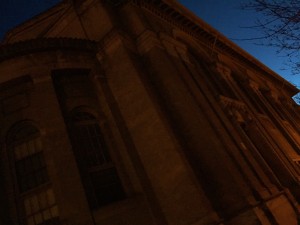 It used to be the Masonic Temple. The imposing stone edifice stood its ground on an angled spit of land at the crooked corner of 32nd and Speer, like a huge ship run aground on a tiny island, looming as night came on. Still, the golden wooden doors looked warm and inviting. Enter here for zazen, the sign read, and it was then I noticed one of the doors barely open, it’s extended deadbolt holding it ajar. The subtlest welcome. I stepped inside.
It used to be the Masonic Temple. The imposing stone edifice stood its ground on an angled spit of land at the crooked corner of 32nd and Speer, like a huge ship run aground on a tiny island, looming as night came on. Still, the golden wooden doors looked warm and inviting. Enter here for zazen, the sign read, and it was then I noticed one of the doors barely open, it’s extended deadbolt holding it ajar. The subtlest welcome. I stepped inside.
Letting the door close softly, I entered the tiny tiled foyer and instant quiet. Shoes lined low shelves along the walls. I saw my face reflected in the glass of the old French doors leading inside, then a small woman in brown Zen robes approaching me from the other side. I smiled as she eased the door open a crack.
“You need to go to an introductory session,” she began abruptly, some East Coast accent adding an edge I did not expect.
“I have done that, though it was a few years ago, at the old location.”
“The old location?”
“Yeah, over on Josephine, I think?”
“A few years ago? That’s a long time ago, that’s like 15 years ago, that’s more than a few years….”
“Are you the one who emailed today?” called a musical voice, softening this meeting. “So sorry, please come in.” My Jersey bouncer looked skeptical but stepped back as a gently smiling middle-aged woman walked my way.
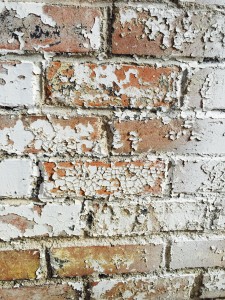
Change happens in stages, sometimes by leaps and bounds, but more often by small steps up the dirt trail and little hops from rock to rock across the water. And so I am not so much beginning as continuing on my way. I took a new job that lets me begin my adventure of leaving home…by coming home to the city I never wanted to leave: Denver. Back here in Denver during the week for work, I added the final requisite irony – I am homeless. I have no official home here currently. So I am staying with generous friends until I land somewhere.
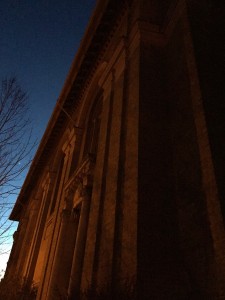 The Zen Center of Denver is a hundred shades of reassuring old brown, from the golden doors and the tan stone exterior to the dark wooden benches built U-shaped into creamy marble alcoves, the polished French doors to the soft matte of the self-stitched robes worn by the practitioners here. A tiny stone Kuan Yin (called Kannon here) is esconced in a wonderful little wooden cabinet centered above the bench where I sat after I was welcomed in. I had never seen this version, Kuan Yin as a mother with small children reaching up to her in the familiar pose of tired little ones, wanting uppie, uppie mama. It touched me, taking me back decades, to the days when my kids were that little…the days when we lived in Denver. A votive candle flickered beside her, a small glass dish of rice left in offering, a small carnation in a diminutive vase. I had expected a stiff initial response at the door, some slight wariness, formality; what surprised me here was the understated earthiness, the utter normalcy – being talked to in ordinary voices, using completely ordinary phrases. Kuan Yin like a young mother. People came and went, small and brown, a genial group with quiet laughter and smiles filling the antechamber to the zendo as we waited together, like sparrows hopping contentedly on the sidewalk outside, finding sunflower seeds in the cracks.
The Zen Center of Denver is a hundred shades of reassuring old brown, from the golden doors and the tan stone exterior to the dark wooden benches built U-shaped into creamy marble alcoves, the polished French doors to the soft matte of the self-stitched robes worn by the practitioners here. A tiny stone Kuan Yin (called Kannon here) is esconced in a wonderful little wooden cabinet centered above the bench where I sat after I was welcomed in. I had never seen this version, Kuan Yin as a mother with small children reaching up to her in the familiar pose of tired little ones, wanting uppie, uppie mama. It touched me, taking me back decades, to the days when my kids were that little…the days when we lived in Denver. A votive candle flickered beside her, a small glass dish of rice left in offering, a small carnation in a diminutive vase. I had expected a stiff initial response at the door, some slight wariness, formality; what surprised me here was the understated earthiness, the utter normalcy – being talked to in ordinary voices, using completely ordinary phrases. Kuan Yin like a young mother. People came and went, small and brown, a genial group with quiet laughter and smiles filling the antechamber to the zendo as we waited together, like sparrows hopping contentedly on the sidewalk outside, finding sunflower seeds in the cracks.
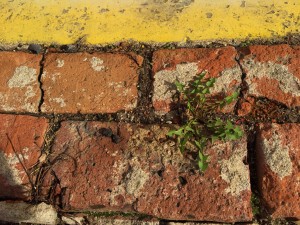 When we choose a spiritual practice, we frame it in the language of the practice itself. So Christians talk about letting go of the things of this world, of being called by the Holy Spirit into a deeper relationship with Jesus, looking to the Blessed Trinity of Father / Son / Holy Ghost, while Buddhists talk about letting go of attachments and taking refuge in the Buddha, the Dharma, and the Sangha, the Three Jewels. Sangha is the Buddhist equivalent of the Christian congregation, the community of saints, which is really the community of sinners who kept trying, really hard. Is there a difference then ultimately, between sinners and saints? Between me, boddhisattvas (those saints of the Buddhist tradition), and the Buddha? The Buddha being just a guy named Siddhartha, similar to a guy named Jesus. Real people, trying to find meaning as a refuge in their real lives, great teachers to other people seeking meaning, seeking refuge, safe shelter.
When we choose a spiritual practice, we frame it in the language of the practice itself. So Christians talk about letting go of the things of this world, of being called by the Holy Spirit into a deeper relationship with Jesus, looking to the Blessed Trinity of Father / Son / Holy Ghost, while Buddhists talk about letting go of attachments and taking refuge in the Buddha, the Dharma, and the Sangha, the Three Jewels. Sangha is the Buddhist equivalent of the Christian congregation, the community of saints, which is really the community of sinners who kept trying, really hard. Is there a difference then ultimately, between sinners and saints? Between me, boddhisattvas (those saints of the Buddhist tradition), and the Buddha? The Buddha being just a guy named Siddhartha, similar to a guy named Jesus. Real people, trying to find meaning as a refuge in their real lives, great teachers to other people seeking meaning, seeking refuge, safe shelter.
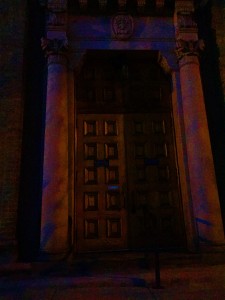
Paramita is a Sanskrit word used in Buddhism to describe where we hope to land, that refuge of meaning. It means perfection, literally “having reached the other shore” – our destination. The other shore is usually interpreted as enlightenment. The six paramitas are the parts of the boat that, used together, can carry us across the endless ocean waves of self-generated suffering to a groundedness that brings more peace. Less tempest of our drama, more temperance of the dharma, so to speak, dharma being how things really are, whether we like it or not. The paramitas can be summarized as generosity, moral compassion, patient endurance, courageous effort, focused concentration, and wisdom. To me, these are the sails and oars that we practice using, gaining skill to sail the boat toward that calm, distant shore just over the horizon.
We sat zazen on brown cushions, silent and unmoving, and I felt…comraderie. Traffic roared by outside the temple, ebbing and flowing with the changing stoplights, and the sound came like ocean waves breaking over us, breaking against our great ship of stone and solid intention as we breathed, together.
This kind of fellowship, it is enough, for now. I do not seek enlightenment. I seek a ship, and a wide, open horizon. My home for now is this sangha, here with these other little sparrows who fluttered aboard seeking refuge and now find ourselves hopping on the deck among the ropes and tackle, hunting around for what might feed and sustain us, some small seed hidden in the cracks. Most of us don’t even realize we are on a ship bound for another shore.
December 7, 2014 / wanderinglightning / 0 Comments
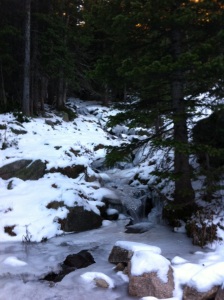 Hiking in early winter, each step is a meditation. If you get lost in your thoughts, snow and ice on the trail remind you of the need for groundedness. So choosing your way becomes your focus.
Hiking in early winter, each step is a meditation. If you get lost in your thoughts, snow and ice on the trail remind you of the need for groundedness. So choosing your way becomes your focus.
I stop periodically, to get my bearings, drink water, notice subtle beauty, like the rich green of the trees among the snowy boulders. Basho’s haiku rings in my mind at each resting place:
Do not follow the ancient masters, seek what they sought.
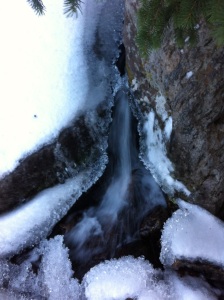
I’m seeking perspective, and acceptance, following the trail I took to scatter my father’s ashes on Long’s Peak. I return every year, to remember, and to continue the journey of letting go. Grief is such a complex feeling, mixing stinging loss with love, disappointment with longing, and memories layered with their own emotions pouring forth from the strange void where the familiar outline has dissolved. These five years later, I understand the mountain stream, which is only frozen on the surface; underneath, the water flows, life continues.
The temple bell stops.
But the sound keeps coming
out of the flowers.
For me, the bell keeps sounding from the stream gurgling low, from my boots crunching up the snowy trail, from the morning sun breaking over the peaks. I will not climb Long’s Peak today; I am choosing my own way, another path without a trail. Beside Long’s Peak is Mount Lady Washington, a 13,281′ class 3 scrambler, which is mountaineer lingo for a huge pile of boulders high above treeline.
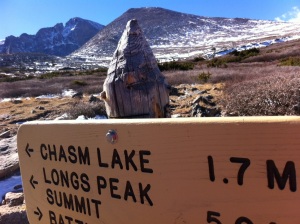
The way begins the same, but diverges without a sign to guide you. Here you can follow in the footsteps of others to Long’s Peak summit and Mount Meeker beyond, to Chasm Lake just below, or to Storm or Battle mountains. But all you know about the way to Lady Washington is what you see here – her peak is just above this pointed sign post. That’s the Lady, and around here, they call her Martha. Aside from that, you’re on your own.
Winter seclusion –
sitting propped against
the same worn post.
This is what I am learning from returning each year. Reading carved signs and following official trails is not hard, whether in the mountains or in life. The sanctioned path makes things easier for everyone. But we often grow the most, create personal meaning, when we find our own way, instead of sitting propped against the same worn post, waiting for life to happen…or wishing it was still happening as it used to. We have to continue, go beyond the marked trail and find our own summit, on our own mountain. Maybe it’s not learning so much as remembering, and accepting.
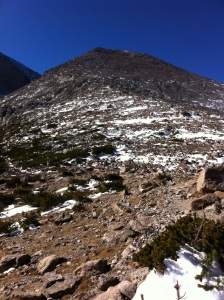
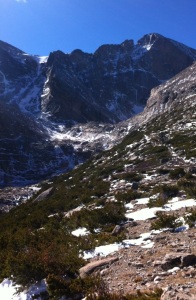
In this mortal frame of mine
which is made of a hundred bones and nine orifices
there is something,
and this something is called a wind-swept spirit….
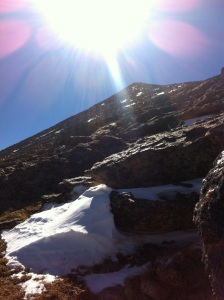
What I remembered as I left the boulder field at Martha’s feet:
Even with 40-50mph winds, if you stay just below the ridgeline you’re climbing, the sun is warm and encouraging
1500 vertical feet takes longer than you think
I’m a better climber on natural rocks than in a gym
Being alone on a mountain is exhilarating solitude
There’s more world for me to explore out there
Winter solitude–
in a world of one color
the sound of wind.
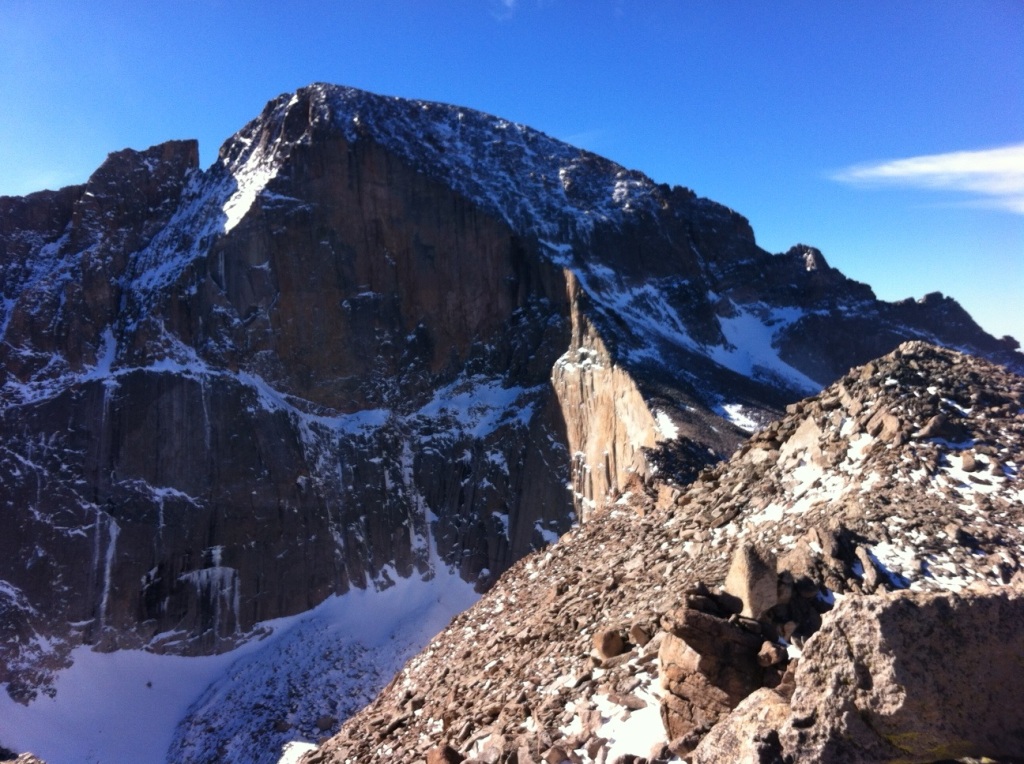 This is what I came here for. This is the perspective of Long’s Peak that you can only get by climbing up beside the peak, not onto it. It is massive, covered in hanging waterfalls of ice, the diamond face so sheer no snow can cling to it.
This is what I came here for. This is the perspective of Long’s Peak that you can only get by climbing up beside the peak, not onto it. It is massive, covered in hanging waterfalls of ice, the diamond face so sheer no snow can cling to it.
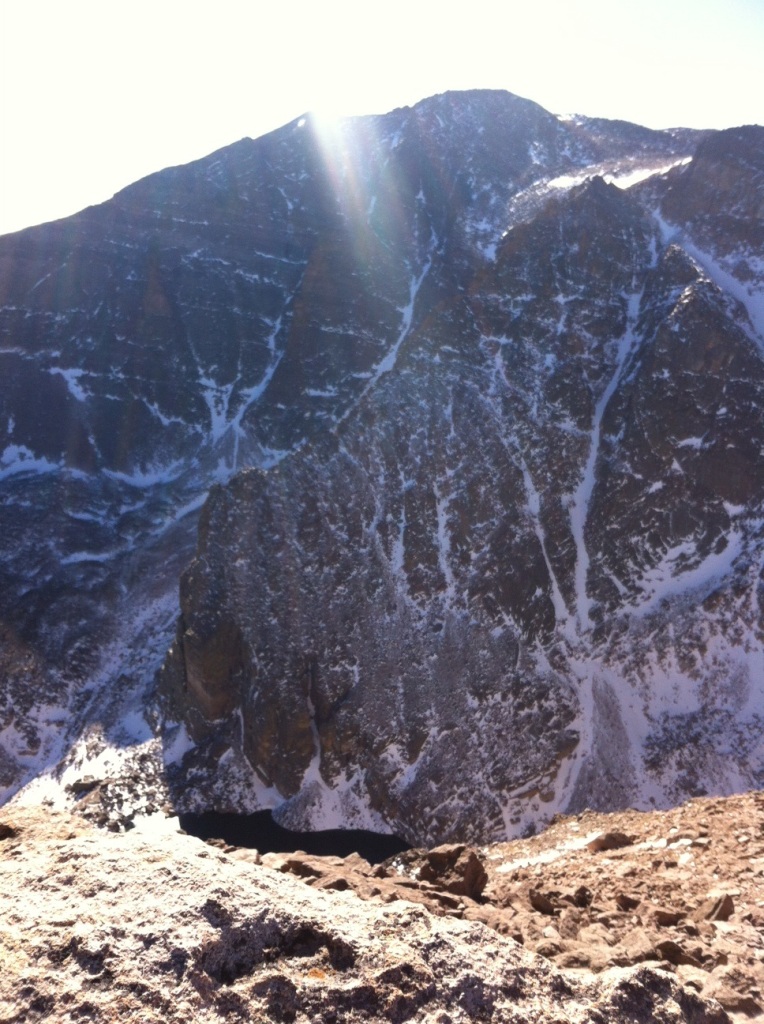
Just left is Mount Meeker, with the incredible Ship’s Prow sailing out of the stone mountain toward me, as if crossing Chasm Lake.
I understand Basho’s words as I stand here on the summit:
Every day is a journey, and the journey itself is home.
What I learned from my father, I bring to my journey. So when I trust myself, I trust the teaching I received, and the judgment I was given space to practice. My father echos through me like the temple bell that never truly stops ringing.
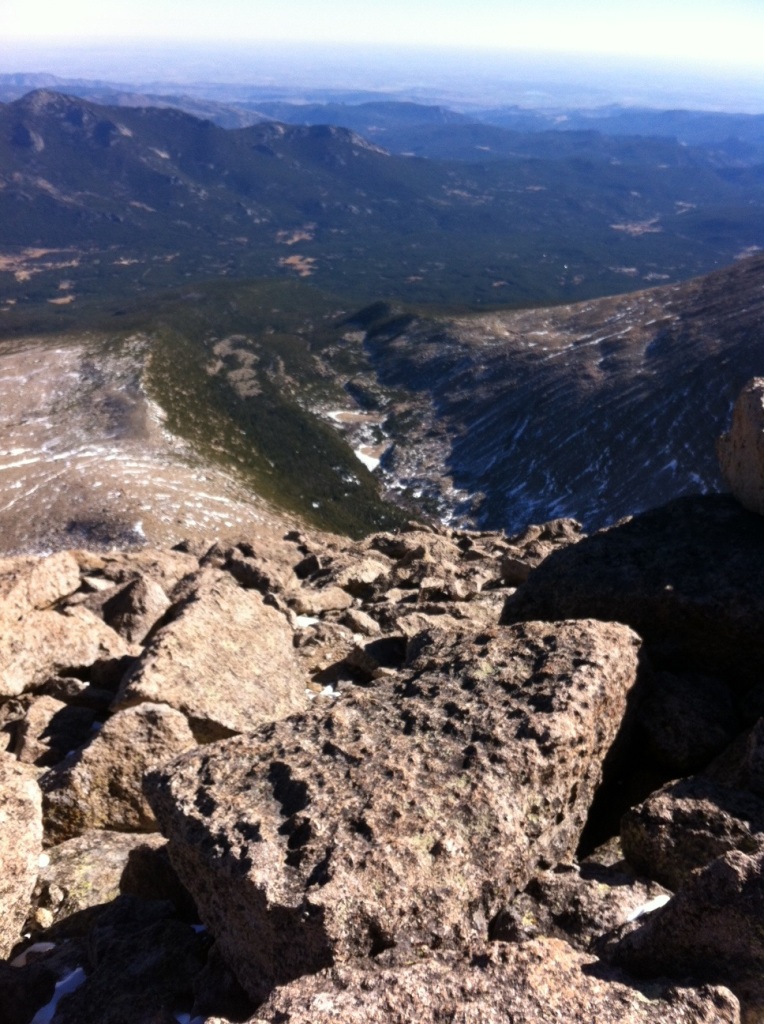
The world seems to unfold before me, and I realize – it doesn’t just seem to, it truly does. All I need to do is remember that, and walk out into it. Follow the echo of the temple bell.
Year’s end,
all corners of this
floating world,
swept.
November 12, 2014 / wanderinglightning / 0 Comments
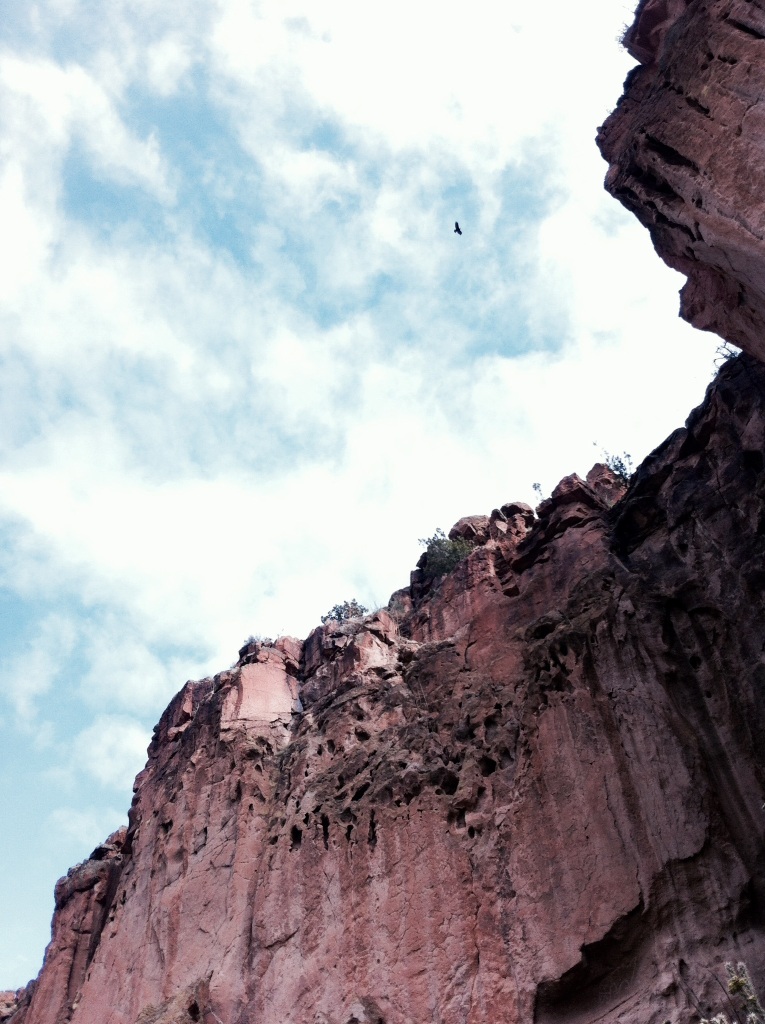
If you go to Bandelier National Monument at sunrise, you arrive to absolute stillness, walking alone through the remains of the dwellings of the Ancestral Pueblo people, letting the silence surround you.
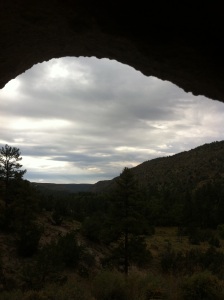
It rained briefly. I sheltered inside a cave used hundreds, even thousands of years ago, by ancient people now long gone. Looking out from the same entrance across the remnants of stone walls, watching the rain slant between the canyon cliffs in the gray light, time seems to pause, bend, and swirl about you.
I’m retracing my steps, as I’m retracing their steps. Twenty years ago, I walked these same paths, looked into these same caves, gazed out over these same walls. Arrayed in a sweeping circle in the narrow valley of Frijoles Canyon, I feel myself circling over them like yet another spirit from long ago.
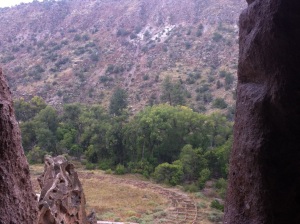
what shall we use
to fill the empty spaces
where we used to talk
how shall I fill the final places
how should I complete the wall
— Pink Floyd, “Empty Spaces”
It was here, at Bandelier, that I first began to realize how walls come to be built: for safety. Trying to keep things safe, we put ourselves and all that matters to us into boxes. Nothing new; I stood looking at a similar attempt created over 600 years ago, Tyuonyi Pueblo. Tyuonyi is thought to mean the place where a significant treaty or agreement was reached, a council site; it was also a home, to about 100 people.
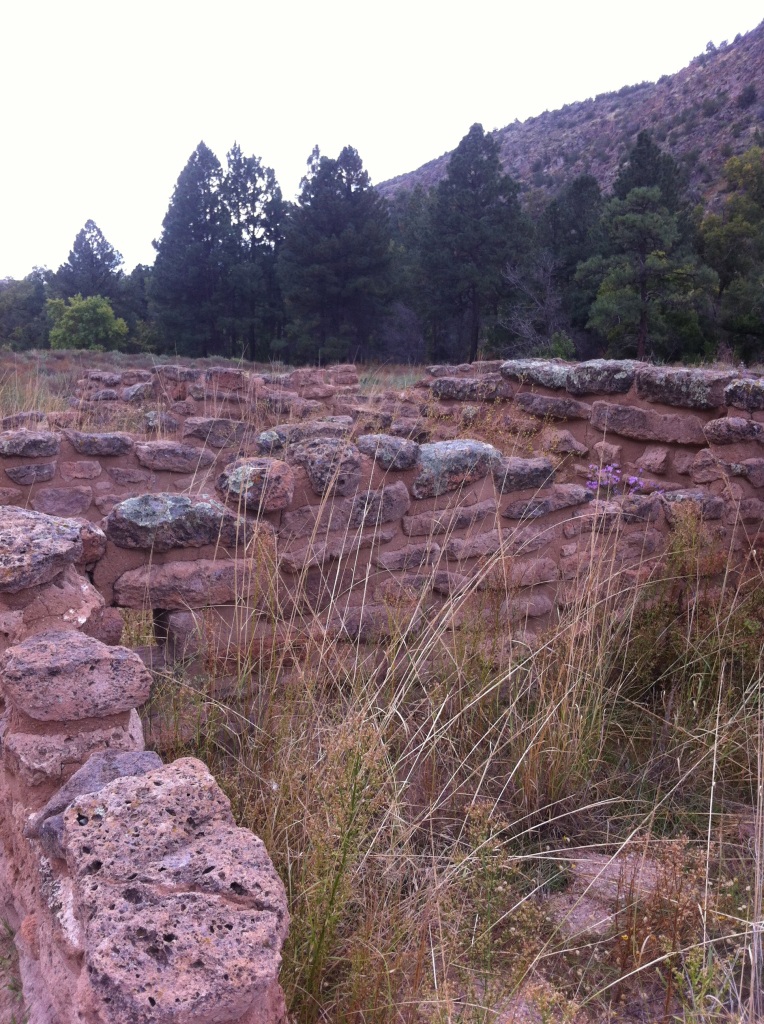
Some made their rooms within the canyon walls, finding caves that they expanded, then walled in, with ladders to reach them.
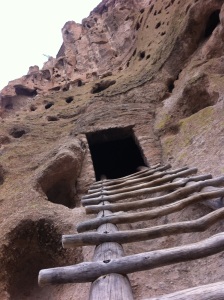
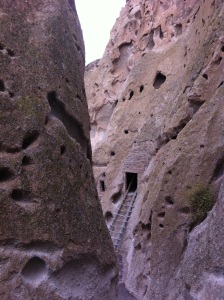
These were the Anasazi, now known as the Ancestral Pueblo; Anasazi is actually a non-Pueblo word meaning “ancient enemies.” It’s unclear why they migrated from the Mesa Verde area to this canyon, and from here, farther south again. Theories include drought, inter-tribal warfare, over-population for available resources, but we don’t really know. What seems clear to me is that each placed they settled into, they thought would last…like their council, and their treaty, and their homes in the stone. But the stone is soft. And the people didn’t stay.
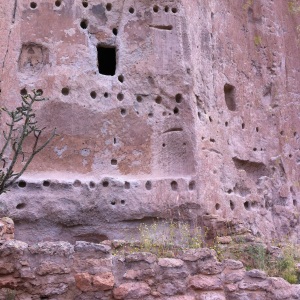
Nothing is built on stone; all is built on sand, but we must build as if the sand were stone. — Jorge Luis Borges
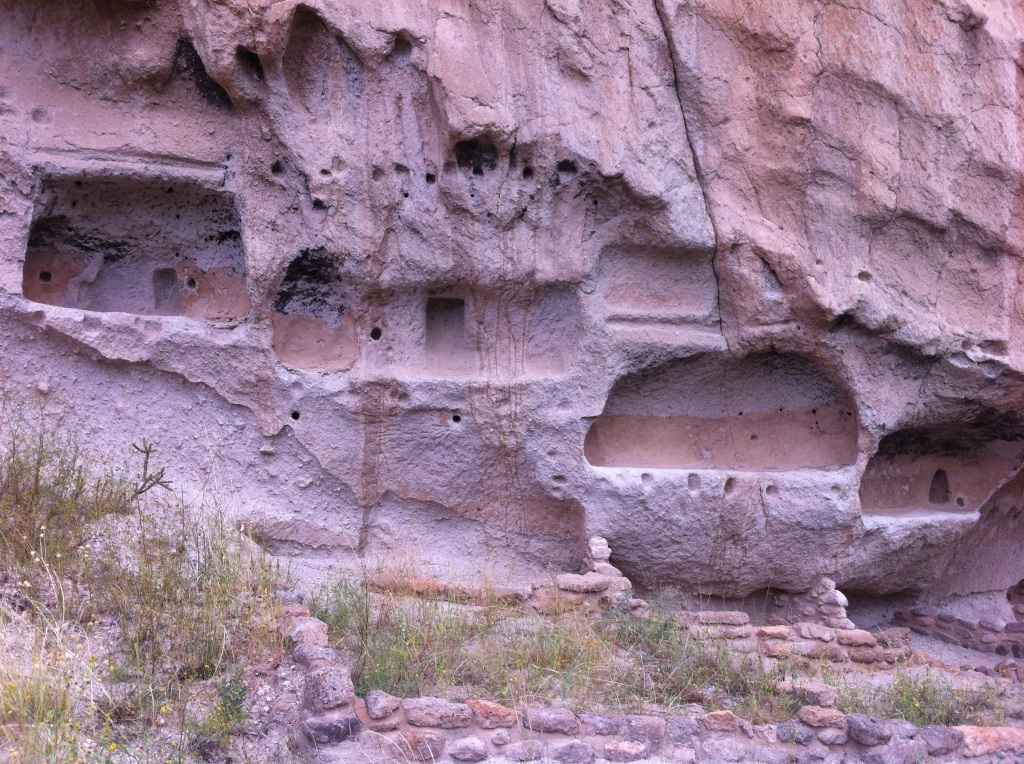
My mind drifts back in time. I came here then trying to mortar the crumbling walls of a home that would not last. I remember intense heat in mid-summer, crowds of people talking, my baby daughter in her little sunhat asleep in the backpack. Now a cool breeze whispers at my cheek; when I turn to look, the memory ripples and disappears.
Memory is the fickle partner of Time, not always reliable, or honest. It shapes itself, giving itself airs of importance, prestige, dramatic meaning. Memory also has a way of evading self-reflection and of blunting sharper edges sometimes, especially regarding the recollector. It is not an accurate historian.
But apart from their skewed narrative settings, remembered images often capture the emotional essence of an experience. Their photographic quality can be powerful for the color and intensity of the feelings associated with the moment. But like dreams, as we try to hold onto the impermanent images themselves, they dissipate, dissolving into the present.
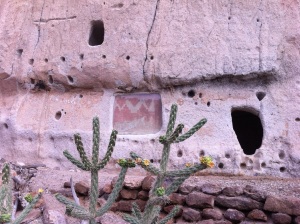
We shape our dwellings, and afterwards, our dwellings shape us.
— Winston Churchill
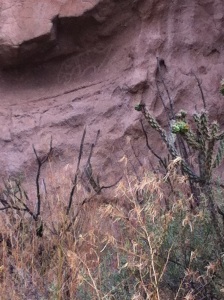
It’s easy to see the ways people here tried to create a sense of home and permanence. Rows of holes show where porch posts and balcony floors were secured into the rock. Natural pigments created painted patterns on walls, and carved images feel familiar somehow. It isn’t hard to imagine children ducking through these cave entrances and running from one doorway to another between stone walls.
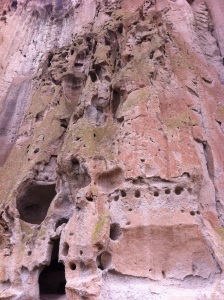
Now the people of this pueblo are gone, voices in the winds of the past. But so am I, so is the younger me who came here in the heat of summer. The dwellings they created have a place in my personal history, and so in shaping my life.
Yet the river of time keeps flowing. The baby is a woman, living in the city, taking the train to work, laughing with friends over coffee. Her laughter waivers in the air around me as I start my jeep and drive on to Tsankawi.
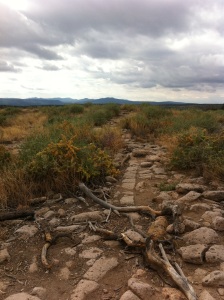
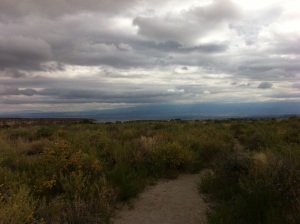
In dwelling, live close to the ground.
— Lao Tzu
While Tyuonyi means a council place, Tsankawi simply gives directions to itself: “village between two canyons at the clump of sharp, round cactus.” I like this meaning; it’s unpretentious. And at Tsankawi, they did live close to the ground. The white stone of the clifftop wore away under generations of bare feet following the same trails, so that now, stone grooves knee-deep to chest-deep in places attest to the interaction of people and earth in a different way than Tyuonyi: here, humans impacted the earth more like water does, wearing away the rock over hundreds of years just by following the flowing course of their daily lives.
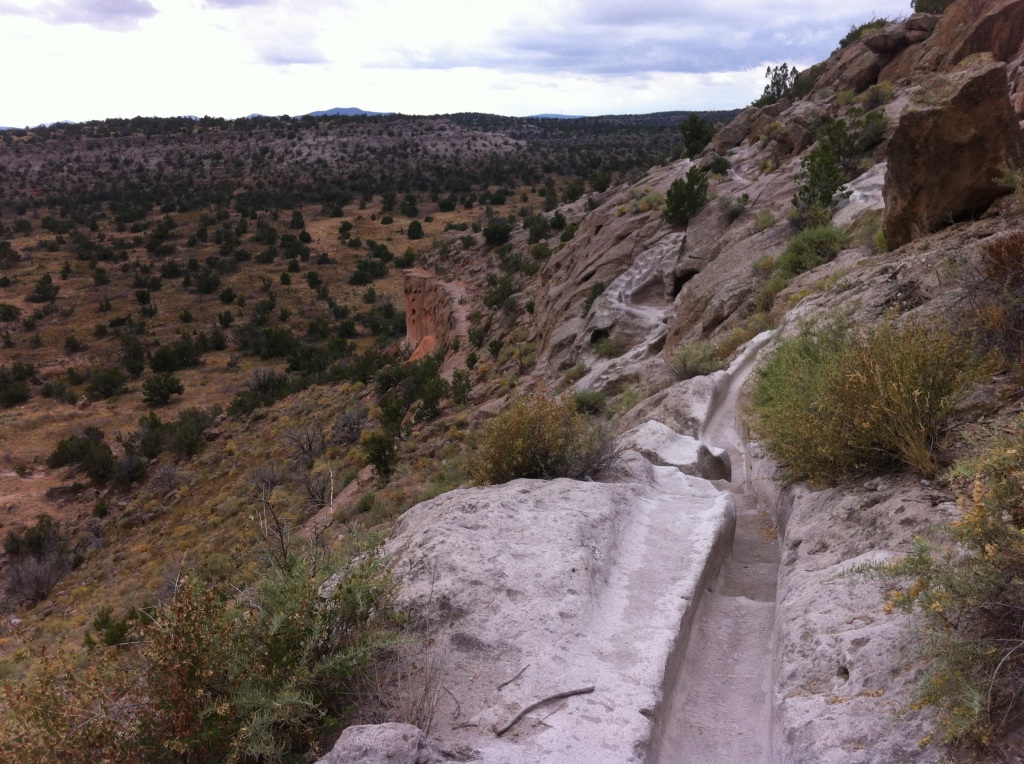
I feel more grounded here. This was the area I had sought to find when I came to New Mexico decades ago, and it lifts my spirits again, this open community on the Parajito Plateau, the breeze from the returning rain ruffling my hair. This was an inviting place to live, centuries ago. Even though people here still used caves in the cliffs, still stacked stone walls to create store rooms, somehow the essence here is open, wide open. “Parajito” is “little bird,” and I see them everywhere, flitting among the brush, lifting and swirling in unison on the rising wind, winging away to wherever they wish to go.
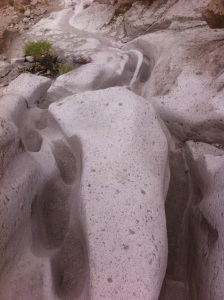
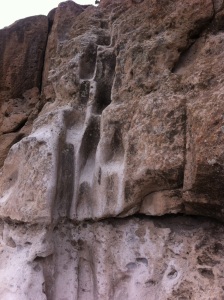 I think it’s the forthright exposure of human presence, vulnerable here on the edge between the two canyons, that pleases my heart. Unlike Tyuonyi, there’s really nowhere to hide. With no intention to hide.
I think it’s the forthright exposure of human presence, vulnerable here on the edge between the two canyons, that pleases my heart. Unlike Tyuonyi, there’s really nowhere to hide. With no intention to hide.
The name tells you exactly where to find the people, how to get home, with no glamorizing story, no muting the canyon winds, no softening of the clump of sharp, round cactus.
I’d rather be at Tsankawi. Let’s give directions to ourselves, that we may be found, and understood, by the people we love. Let’s be at home in ourselves, sinking deep into a grounding that is at once both solid and open. Let those we love become los parajitos, the little birds who are lifted above us and able to become whomever they choose, flying wherever they wish to go. Let us walk along the canyon edges and be free.
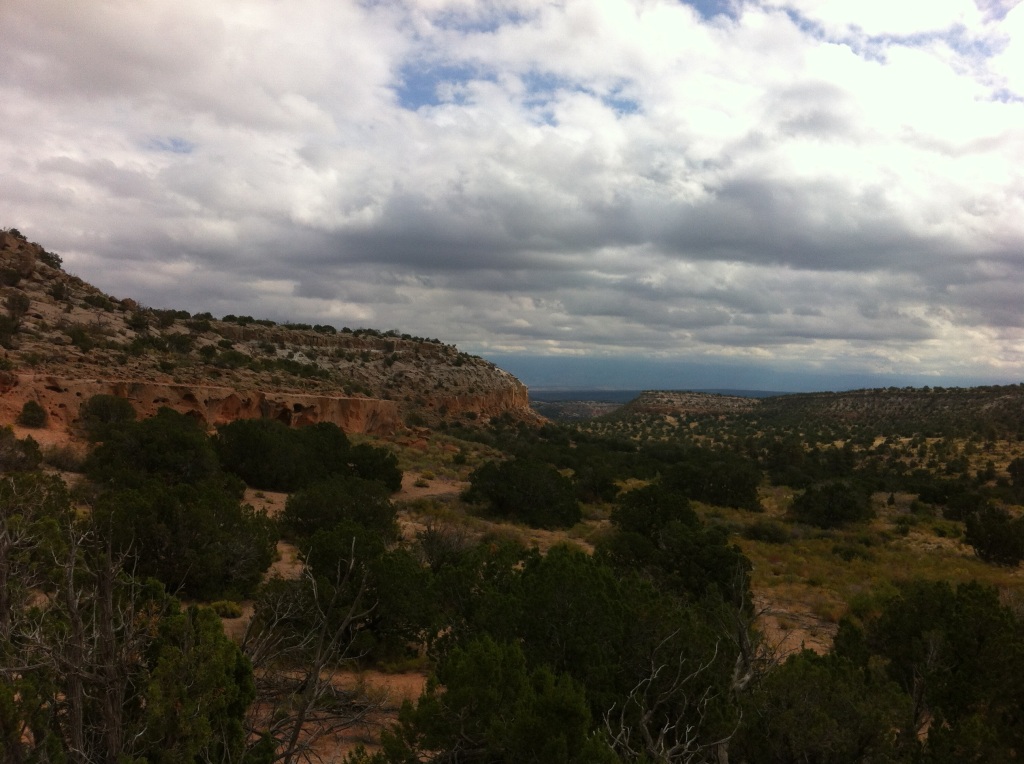
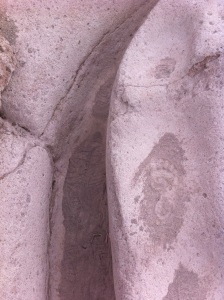
What you leave behind is not what is engraved in stone monuments, but what is woven into the lives of others.
— Pericles
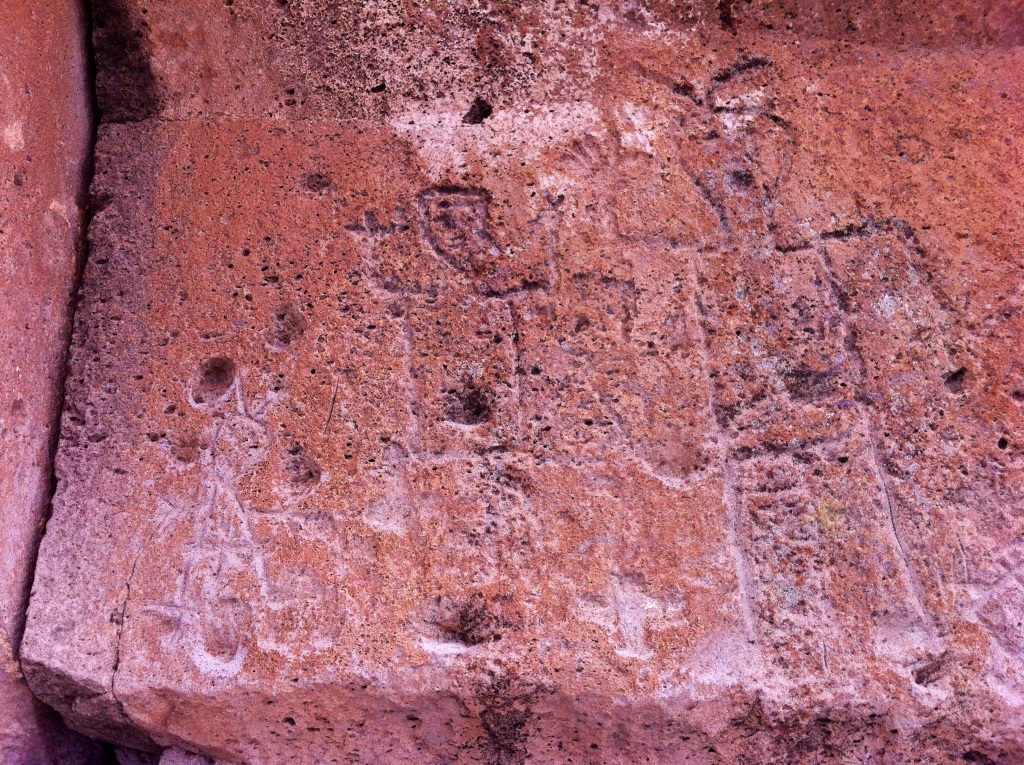
October 26, 2014 / wanderinglightning / 0 Comments
I woke before dawn, before my alarm, in the upstairs dorm at Upaya Zen Center. I could just make out the outline of trees through the window. A dog barked indistinctly, some distance away, but otherwise, all was still. This quiet Sunday, my final morning of the weekend retreat, was in fact noticeably still. I felt fortunate to have awakened before the bellringer arrived, a resident in a brown robe who entered each adobe house at 5:30am to let the bell call us to practice… practice… practice….
I slipped out of bed, curling softly down the spiral metal staircase and out the door to the adjacent house, where our morning tea was available. No one in the kitchen; odd, since yesterday, several people came and went at nearly this same time. My mug of tea warm in my hands, I stood a moment in the courtyard between houses, looking up. Slowly twinkling stars answered back the silence we come here to find.
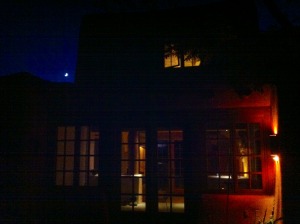
Quietly I returned, to my dorm, to the soft rug before the unused fireplace, to myself, here in this moment between all things, this silence alone. I sat on the rug and faced the windowed doors that lead out to the gardens, now black but faintly shining with the low lamplight. I sat, and I sipped tea, and I waited for the bellringer, and the morning.
It was when I’d nearly finished my tea that I wondered where the bellringer had gotten to. What time was it? I tiptoed back upstairs and checked my clock: 5:46. No one else was up. I walked out to the paths that lead to the zendo; I met no one. I passed the dark zendo and walked to the main hall; nothing stirred.
This is what I love and scratch my head about with Buddhists: just when you think you understand the rules of the game, they switch it up, to keep you from getting too comfortable with your ideas about yourself. Obviously, I had missed a very clear direction regarding today’s final schedule, but now when I looked for it posted, it was nowhere to be found. No signposts for me to get back on track. It was just up to me now, this morning, to choose how to respond: wait? go back to bed? practice on my own on the dorm room rug? yell out, “Olly olly oxen free”?
I lose track of time. Often. Or I grab it like a drum major thrusting that long, golden mace up high above the marching band, keeping such close count of the time it’s all I can see, all I can feel, all that matters. Until I drop it and lose all track again. Time, which I have long considered my nemesis, a trickster, coyote, was laughing at me again, silently under the stars.
La carretera is Spanish for both the road we travel and also the load we carry upon that road. I think of this as the burden we have loaded upon ourselves, usually. Time is often la carretera, the burden and the road, a long route which appears on the map as school, work, projects, deadlines, career, decisions – disillusionment, longing, and loss, followed inevitably by old age, sickness, and death, those tres amigos who live down at the end of that road.
“Well we know where we’re goin’
But we don’t know where we’ve been
And we know what we’re knowin’
But we can’t say what we’ve seen…” — Talking Heads, Road to Nowhere
I realized that today, however, with no one up, no one near, no schedule and no responsibilities left to complete here, I could do what I love to do when I find a beckoning doorway between the hours – run away. Off road. No map – spiritually speaking.
So I grabbed my pack and left Upaya before dawn, as if the rising sun would close that magic door. But it didn’t. It illuminated the Guadalupe of the City of Holy Faith, out front of the Santuario de Guadalupe Santa Fe, La Virgén standing serenely over the stooped men drifting slowly, one by one, across her sloping plaza by the river, under a glorious pink and orange sky.
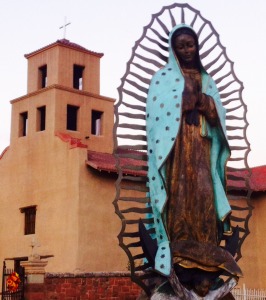 If you meet the buddha on the road, you’re supposed to kill him, according to the ancient Zen texts. They mean let go of what you believe enlightenment to be, your idealized personification of how to be in the world, usually defined as somehow not you. But what if you meet Guadalupe, over and over? I feel I am expanding, not limiting myself, by loving her personification of compassion, here among these quiet men with all the hallmarks of homelessness upon them. She feels reassuring to me, and her crowd feels very familiar.
If you meet the buddha on the road, you’re supposed to kill him, according to the ancient Zen texts. They mean let go of what you believe enlightenment to be, your idealized personification of how to be in the world, usually defined as somehow not you. But what if you meet Guadalupe, over and over? I feel I am expanding, not limiting myself, by loving her personification of compassion, here among these quiet men with all the hallmarks of homelessness upon them. She feels reassuring to me, and her crowd feels very familiar.
I just can’t kill her.
These musings occupied my mind as I left town, heading toward Taos – or so I thought, until I realized I was somehow going south. Even if you’re pretty good with maps, many of the roads between Santa Fe, Chimayo, and Taos stop and start, or simply do not appear on the map at all. Pulling over countless times to make U-turns, you have plenty of opportunity to review your relationship to maps and roads. I kept finding myself in the vicinity of where I wanted to be, without being able to figure out a road to actually get me there. So close and yet so far. And as I sat parked on the side of yet another winding road arcing away to who knows where, I thought about what I was doing.
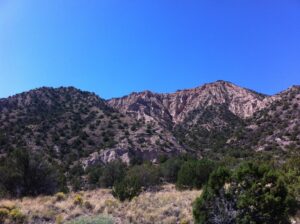
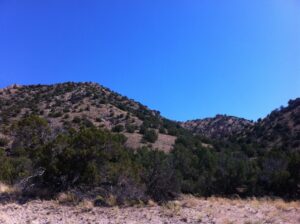
“…We’re not little children
And we know what we want
And the future is certain
Give us time to work it out…”
We choose our destination, and then we fit our roads to our course. But that’s not how it works in New Mexico. Or in life. I was trying to pick a direct route where none existed, trying to control my “off map” adventure by making it conform to the way maps work. The destination is a nice idea, but we can’t change the road or force it to get us there. Choose a different way…or a different destination. Or maybe, just quit choosing and controlling for a while. That is going off the map.
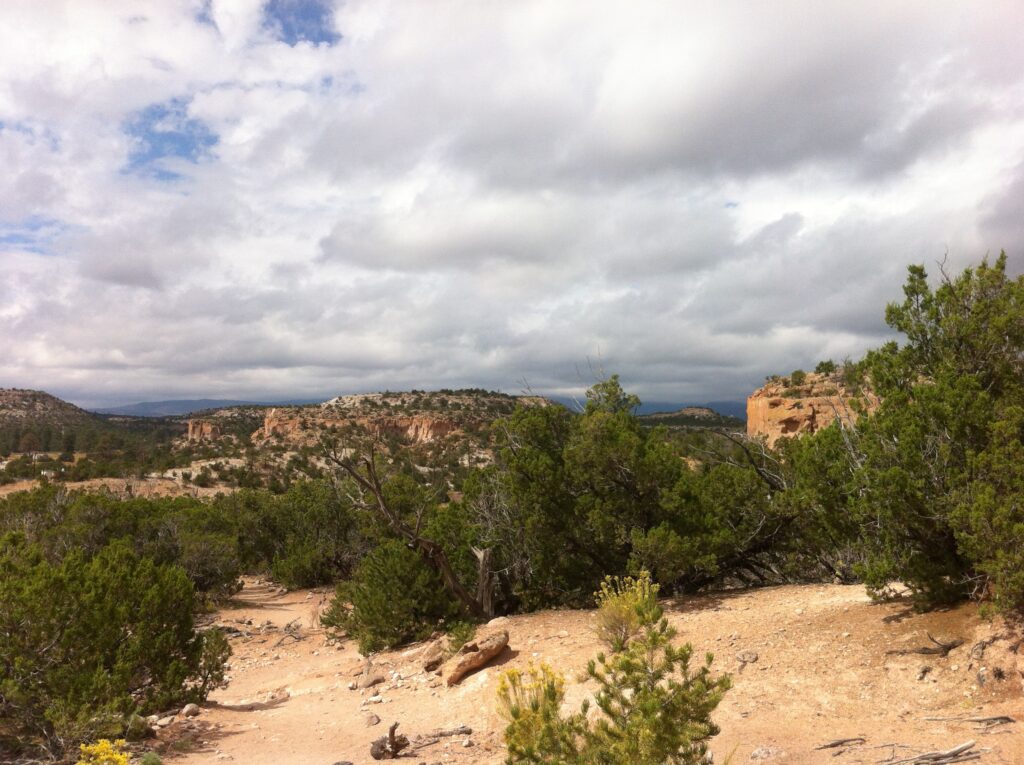
“We’re on a road to nowhere
Come on inside
Takin’ that ride to nowhere
We’ll take that ride…”
So I continued on whatever road I was on, and let myself relax into the easy swaying rhythm of curving among the hills, which brought me to the beautiful and mysterious places of northern New Mexico, to Bandelier, and Tsankawi.
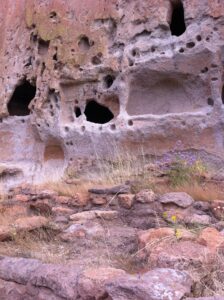
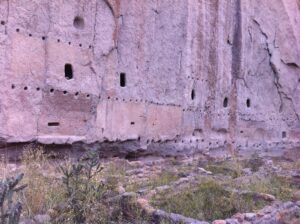
“I’m feelin’ okay this mornin’
And you know,
We’re on the road to paradise
Here we go, here we go…”
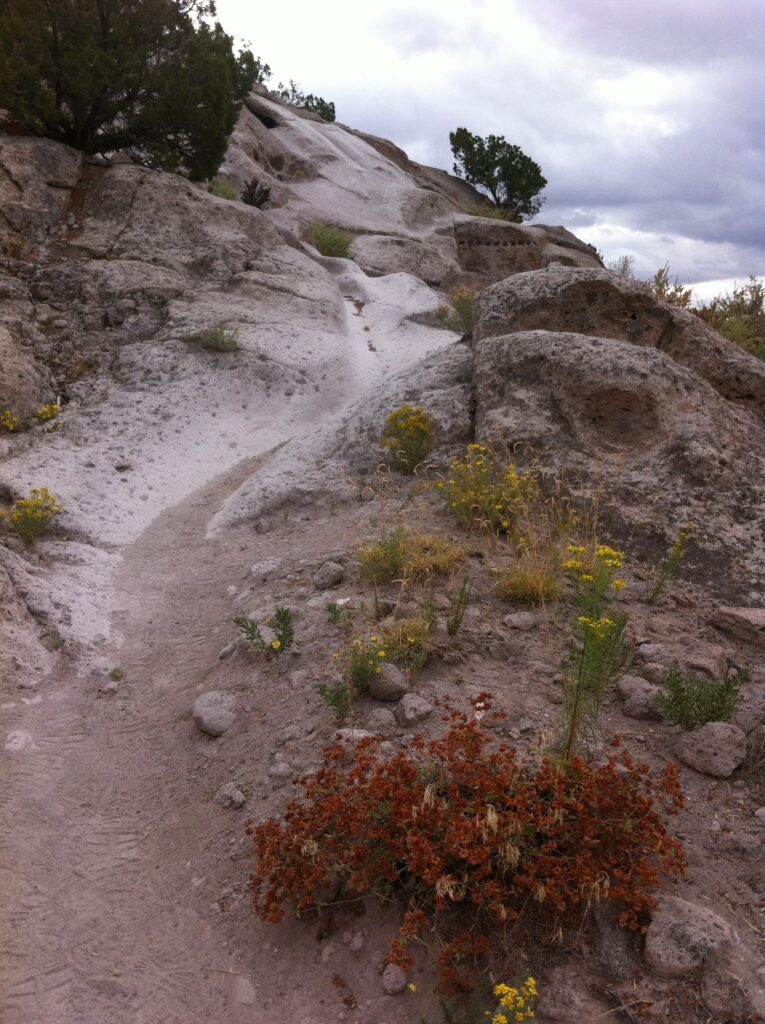
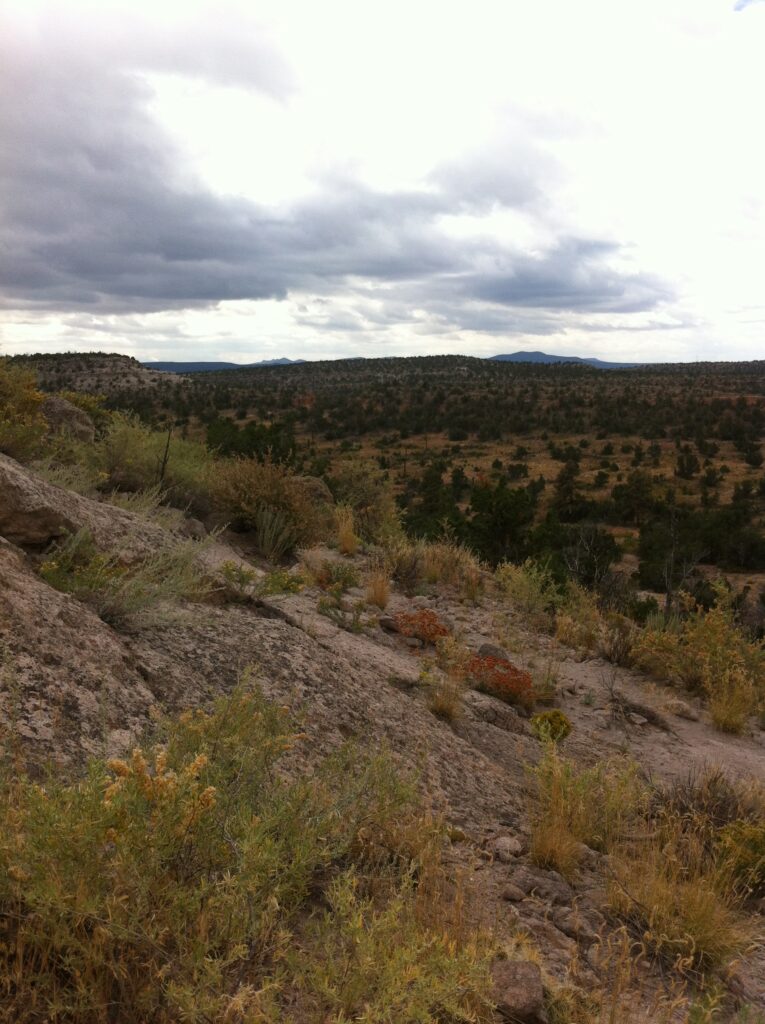
It’s fascinating that as maps and destinations lose their hold on you, time slips off your shoulders as well, and the day rolls out before you like a broad and inviting trail. I hiked and drove, and stopped and looked, and by more back roads Taos Mountain eventually came into view, and suddenly, by surprise, I arrived. I asked directions of a local woman manning a parking lot fee kiosk, ristras of chiles hanging all around her like fiery braids. She told me to “go five lights” to find my way back toward Tres Piedras and Colorado – five lights because that’s how they give directions here, since the roads keep changing directions. Follow the lights. Navigating by stars again.
The Rio Grande Gorge awaits you northwest of Taos, a farewell sendoff on the road home. As I crossed the bridge, I noted all the vendors displaying their wares along both sides of the road, on both ends of the bridge. After crossing I parked, to walk back and stand in the middle of the bridge over this spectacular, narrow canyon, the wind swaying the steel under my hands, the concrete under my feet.
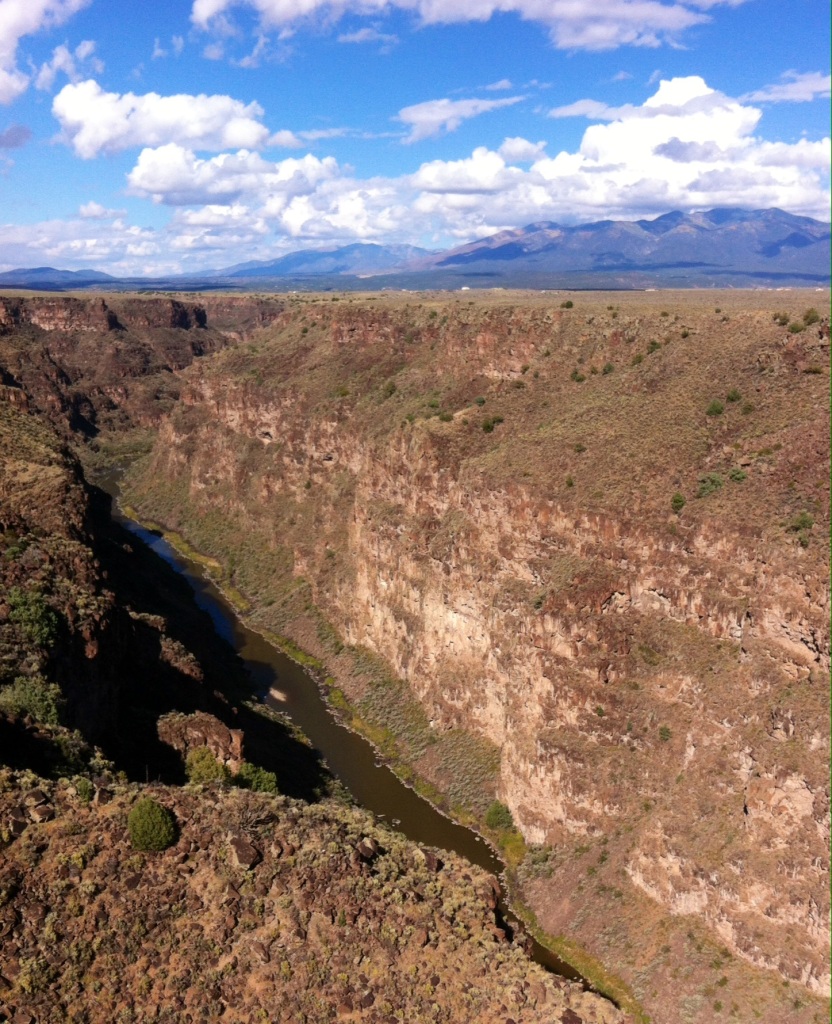 I turned to go, when one artist’s work caught my eye, and so I crossed back on foot to the Taos side of the bridge. Here sat Mark A on a folding chair outside his van, a big man with a woodworker’s hands and many hard years etched around kind eyes, carving an old gray wooden post into an icon of a saint, his other santos on the long white table in front of him. He sells them too cheap, he knows, but…, he says, and shrugs, smiling. An 8″ tall Mary and Joseph carved from tree branches stand together, their expressions loving and real; they must be sold together, I am told. Saint Francis sits solidly on the table holding a bird, clearly carved from the same type of gray post that will now become another image of Mother Mary. I pick up a smaller female image, with a crown and a long robe. “I just came from the zen center in Santa Fe,” I tell Mark A, “and this one reminds me of Kuan Yin. You know her?”
I turned to go, when one artist’s work caught my eye, and so I crossed back on foot to the Taos side of the bridge. Here sat Mark A on a folding chair outside his van, a big man with a woodworker’s hands and many hard years etched around kind eyes, carving an old gray wooden post into an icon of a saint, his other santos on the long white table in front of him. He sells them too cheap, he knows, but…, he says, and shrugs, smiling. An 8″ tall Mary and Joseph carved from tree branches stand together, their expressions loving and real; they must be sold together, I am told. Saint Francis sits solidly on the table holding a bird, clearly carved from the same type of gray post that will now become another image of Mother Mary. I pick up a smaller female image, with a crown and a long robe. “I just came from the zen center in Santa Fe,” I tell Mark A, “and this one reminds me of Kuan Yin. You know her?”
“Yeah, Kuan Yin, she is kind. My friend, he is one of the heads of the zen center we have here in Taos. He’s 94 years old, but he comes over to my house to visit me every day. I like zen. She was Mary, but she reminds you of Kuan Yin, yeah?” I want to tell him how much his work means to me, and how humbled I feel to have found him here on another road to nowhere. I buy the Kuan Yin, and Saint Francis, whose face reminds me of this santero, carver of saints. No killing this buddha on the road, either.
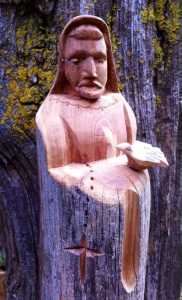
“Vast is the robe of liberation…,” we chanted as we sat together in the zendo, under the statues of Kuan Yin, known also as Kannon, and Avalokiteshvara, all “She Who Hears The Cries of The World.” This is also just another description of Our Lady of Guadalupe, whose beautiful blue robe covered in constellations of stars is simply the sky, to my eyes, the universe, compassion being the liberation of both the one who gives it as well as the one who receives it. Vast within the universe is our ability to step under that wide robe and out of time into a space that prioritizes the moment – and the person – right in front of us.
I guess I was off-map as we chanted, however; I thought we were all saying, “vast is the road of liberation.” Losing track seems to be mi carretera. And my hope.
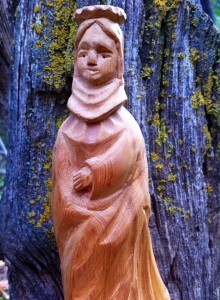
“Maybe you wonder where you are
I don’t care
Here is where time is on our side
Take you there…take you there
“We’re on a road to nowhere
We’re on a road to nowhere
We’re on a road to nowhere….”
October 11, 2014 / wanderinglightning / 0 Comments
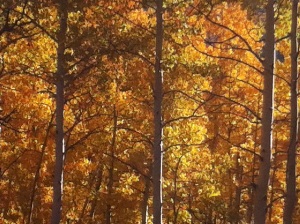 Warm in the autumn mid-afternoon, I am lazily swooning in the fiery, shimmering gold of Colorado aspens in the high country. I see each fluttering leaf, smell the dry leaves underfoot, and hear the whispering quaking…and a guy cough. Next to me, on his meditation cushion. Which brings me back to reality, here in Upaya Zen Center, in Santa Fe, New Mexico. Again and again, my mind drifts with the cool breezes that curl in through the high windows of the zendo.
Warm in the autumn mid-afternoon, I am lazily swooning in the fiery, shimmering gold of Colorado aspens in the high country. I see each fluttering leaf, smell the dry leaves underfoot, and hear the whispering quaking…and a guy cough. Next to me, on his meditation cushion. Which brings me back to reality, here in Upaya Zen Center, in Santa Fe, New Mexico. Again and again, my mind drifts with the cool breezes that curl in through the high windows of the zendo.
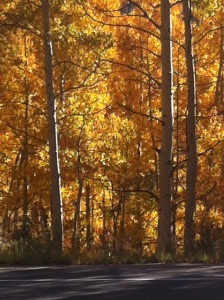 The trees. The aspens were spectacular this year, not just golden and bright as the sun, but flaming orange, and even red on a few mountain ridges. What incredible beauty I drove through to…breathe, and notice breathing, here in the zendo. Notice being here.
The trees. The aspens were spectacular this year, not just golden and bright as the sun, but flaming orange, and even red on a few mountain ridges. What incredible beauty I drove through to…breathe, and notice breathing, here in the zendo. Notice being here.
How many times do we not. In this day of silent meditation, my mind spins out stories, images, scents and sounds, until the windy rattling of the leaves of an entire aspen grove fills my mind with a completely false reality. It’s like napping with your eyes wide open.
“To be awake is to be alive.” — Henry David Thoreau, Walden Pond
The irony is that this Southwestern-style adobe Buddhist temple is spectacular, as well. Enormous posts of entire, peeled tree trunks anchor roughcut beams across the thick plaster walls. Rugged, natural wood is embedded over doorways and windows as reassuring lintels, sturdy vigas line the porch roofs and stud the smooth walls, and everywhere filtered light and softly moving air soothe and refresh. The floor is polished to a shine that reflects the light and shimmers like a lake, and I drift away in watery reveries repeatedly.
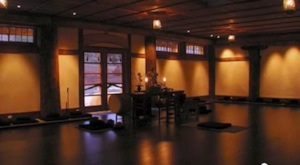
When I’m actually facing out into the room. Most zen meditation is done facing the wall. You sit maybe a foot or two away from the wall, and now, all distractions removed, you pay attention, to…sitting and breathing in front of a wall. It’s trickier than it seems, and not nearly as boring as it sounds.
Because our minds are such noisy places to live in. It’s exhausting when you first start to explore this mental terrain. That exhaustion quickly leads to the stage of life when you think you will move to a calm, quiet place, Thoreau’s cabin in the woods, where you can be happy and live simply. But what does it matter, if we live in an isolated cabin an hour from anywhere or in the middle of New York, if we bring the constant chatter-talk-drama-sirens-blaring-teary-confessions-angry-yelling-windows-breaking-hopeless-addict-craving-thrills-success-and-money-fame-nirvana with us everywhere we go?
Zen: sit down, shut up, face your wall.
Or in my case, face your tree.
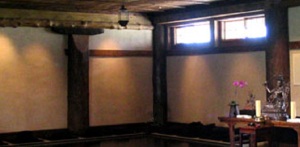
See the very thick post on the left wall? That’s my tree. My assigned seat for the weekend was directly, exactly, in front of it. As you enter the sacred space, you bow to it, hands together. You walk slowly to your place, turn to face the room, and bow to all. You turn to your seat, and you now bow to it, this humble place that is the soil of the seed of your potential wisdom.
“All change is a miracle to contemplate; but it is a miracle which is taking place every instant.” — Thoreau
We do not bow, in general, in America. Honoring is a pageant here, not an act of humility – an awards ceremony, 21-gun salute, Oscar nomination for Best Picture, valuable cash prizes. But outside the pageant, in our daily lives, we curse each other in road rage, roll our eyes and sigh while in line for our five dollar coffees, and tell little cutting stories about how our kids are actually somewhat superior to your kids gosh look at the time gotta go. We compete with each other for what shimmers like glory, that fleeting popularity, status and bragging rights, instead of offering genuine respect and honor to each other, intentionally, and with all sincerity. Seems we won’t bow to the forest for all the damn trees.
So, I bowed to the temple, and I bowed to the sangha of fellow human beings, and I bowed before I took my seat, and then, I bowed to my tree. With all sincerity. As Robert Frost would have said, my tree was “lovely, dark, and deep,” the grain a fingerprint of its life, with swellings and whirls where branches might once have been. As I sat examining its scars, it occurred to me that trees seem like the most enlightened living beings on the planet, which I know makes me sound like a kook. But when you think about it, trees: demonstrate no passions, aggressions, or ignorance; are nobly rooted to the earth and stretch their crowns toward heaven, just as we are instructed to do in zazen; engage in no profane words or deeds; live according to the seasons of their lives; shelter smaller living things that seek them; make their own food, plus food and oxygen to nourish and sustain all life on this planet; inspire us with their simple beauty and fitness of purpose, as true bodhisattvas do; and demonstrate their enlightenment by their ability to bend and bow, honoring the way life is, instead of fighting to have their way.
“I turned my face more exclusively than ever to the woods, where I was better known.” — Thoreau
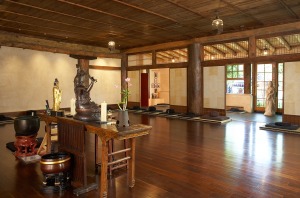 Such a small space, between me and my tree, between me and the guy next to me, who still occasionally coughed. I looked deeply into that trunk before me, and saw generations of trees, growing together, just like we were all trying to grow together, sitting side by side. Just like aspen, we are all one organism below the surface, appearing as separate individuals – but that is actually an illusion. What we do to one, what we do to each other, we do to all. We do to ourselves. Because we act upon the whole world, whether in rage or in humility.
Such a small space, between me and my tree, between me and the guy next to me, who still occasionally coughed. I looked deeply into that trunk before me, and saw generations of trees, growing together, just like we were all trying to grow together, sitting side by side. Just like aspen, we are all one organism below the surface, appearing as separate individuals – but that is actually an illusion. What we do to one, what we do to each other, we do to all. We do to ourselves. Because we act upon the whole world, whether in rage or in humility.
I swayed with the aspens periodically, but that solid trunk, unmoving before me, would bring me back. And so did the very humanness of the people sitting beside me, many trees within the Circle of the Way.
“I went to the woods because I wished to live deliberately, to front only the essential facts of life, and see if I could not learn what it had to teach, and not, when I came to die, discover that I had not lived.” — Thoreau, Walden Pond
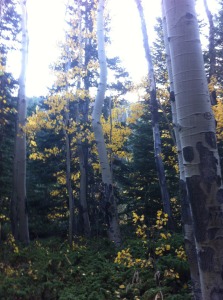
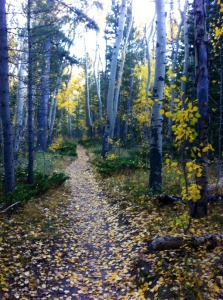
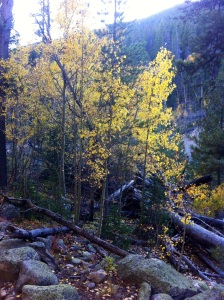
October 9, 2014 / wanderinglightning / 0 Comments
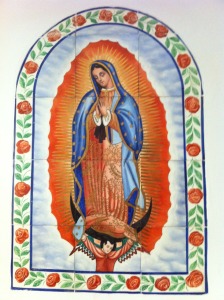
When on the road to see Our Lady of Guadalupe, you will come by many turns to Santa Fe. Roughly translated, “Santa Fe” means “city of holy faith.” The Guadalupana is Santa Fe’s gentle patron saint, a vision of kindness and mercy whose call from the hills, according to the legend, sang like the voices of many sweet birds, down to the listening ears of the peasant Juan Diego passing below:
“Let not your heart be disturbed. Do not fear….”
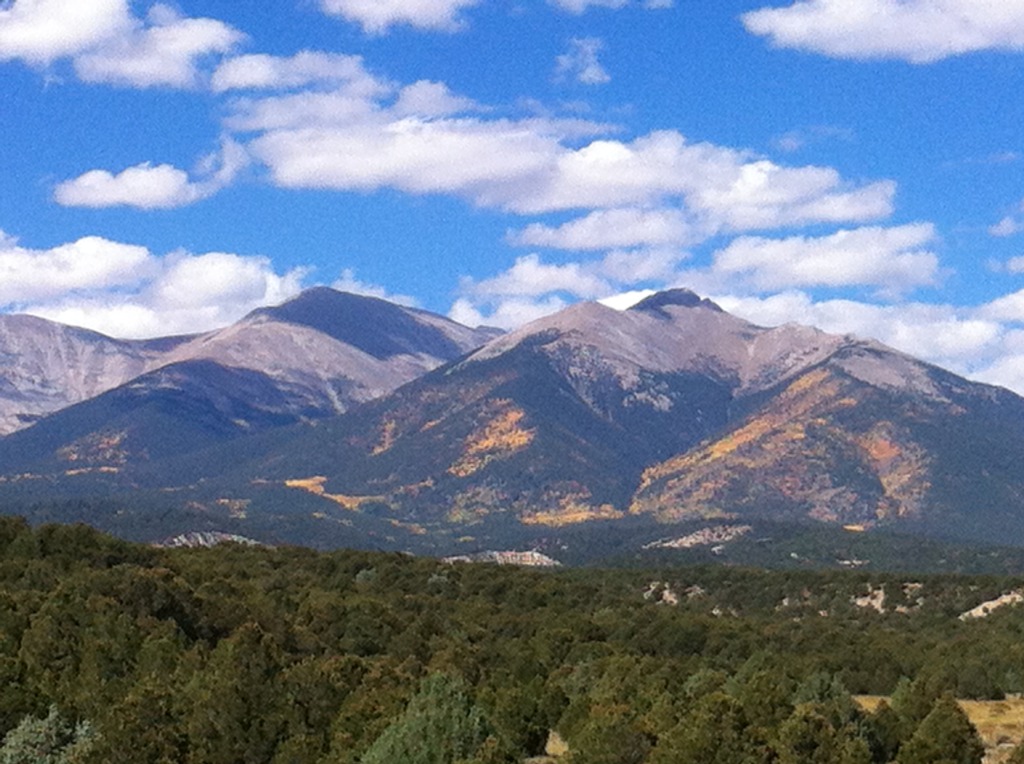
The mountains of Colorado drop back as you travel south, and the expanding vistas of northern New Mexico beckon. Beyond those guiding peaks, the road begins to meander. And so do I.
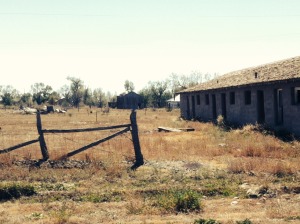 At the border sits Conejos, the only county seat in the state that’s not an actual incorporated town, population 58, total area less than half a square mile.
At the border sits Conejos, the only county seat in the state that’s not an actual incorporated town, population 58, total area less than half a square mile.
But here, Nuestra Señora de Guadalupe, Our Lady of Guadalupe Catholic Church, watches over the long San Luis Valley. The brick version is from 1948, but originally, in 1858, Our Lady raised picket walls, called jacal, around the valley faithful.
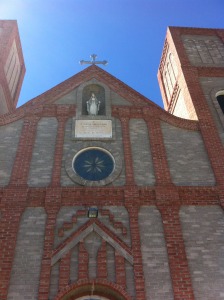
“Are you not under my protection? Are you not happily within my fold?”
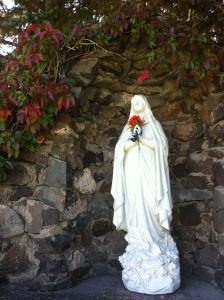 Our Lady of Guadalupe is beloved here, found again and again all along the way from Conejos to Santa Fe. Her story was published in the Nahuatl/Aztec language in 1649. The text is called the Nican Mopohua, “Here It Is Told.” It tells a story from 1531, blending Aztec, Chichimecan Indian, and Christian beliefs, wrapping ancient imagery of the Sun God and the Earth Mother in the new mysticism of Catholicism. In the story, Our Lady asks Juan Diego to build her a church on the holy hill; in this part of the country, she has been given many shrines, many hills to call home.
Our Lady of Guadalupe is beloved here, found again and again all along the way from Conejos to Santa Fe. Her story was published in the Nahuatl/Aztec language in 1649. The text is called the Nican Mopohua, “Here It Is Told.” It tells a story from 1531, blending Aztec, Chichimecan Indian, and Christian beliefs, wrapping ancient imagery of the Sun God and the Earth Mother in the new mysticism of Catholicism. In the story, Our Lady asks Juan Diego to build her a church on the holy hill; in this part of the country, she has been given many shrines, many hills to call home.
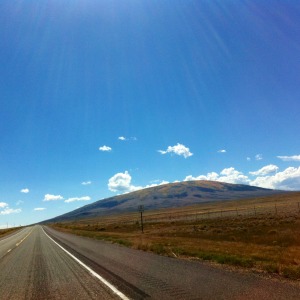
I am a peregrina, a pilgrim rolling south past the graceful arc of New Mexico’s earthen gatepost, San Antonio Mountain. I think of the hill of Tepeyac, where the apparition of “the ever-virgin Holy Mary, Mother of God” called affectionately to “Juanito,” asking him,
“Am I not here, who is your Mother?”
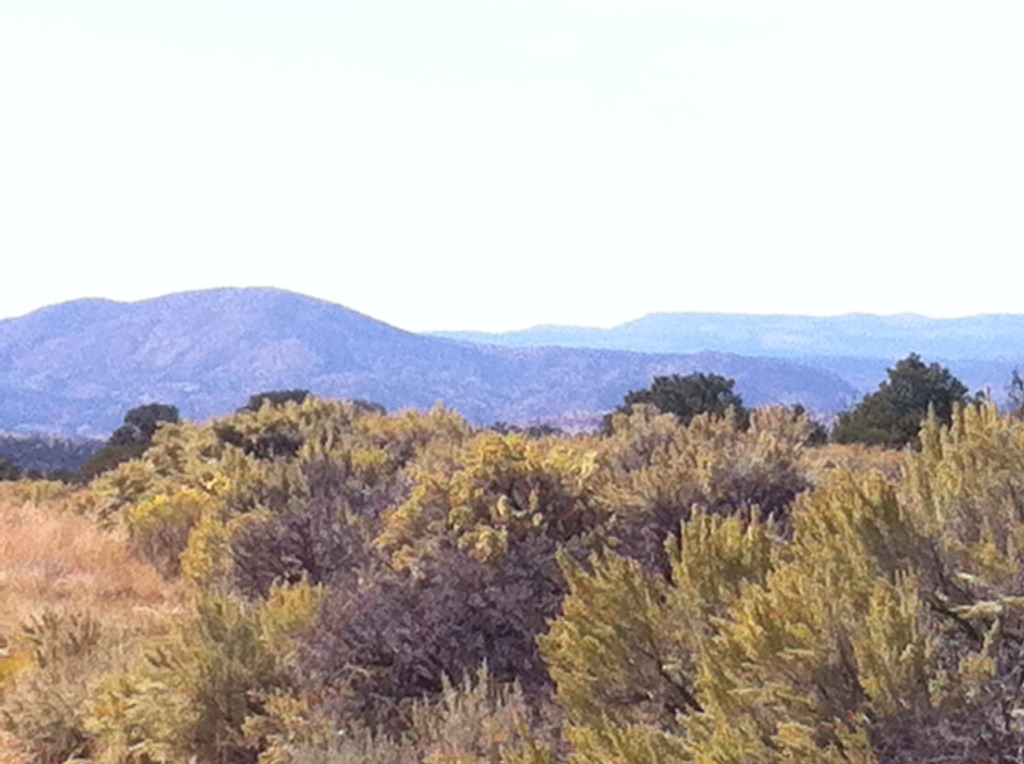
New Mexico is a feminine landscape. The hills are softer, green and gold of rounded desert chamisa, that sweet-smelling rabbitbrush, the evergreen piñon, and turquoise sage. Mesas stretch slowly across the horizon, indistinct as the last moments of dreaming upon waking, clouds continually forming far across immense valleys over distant, fading hills.
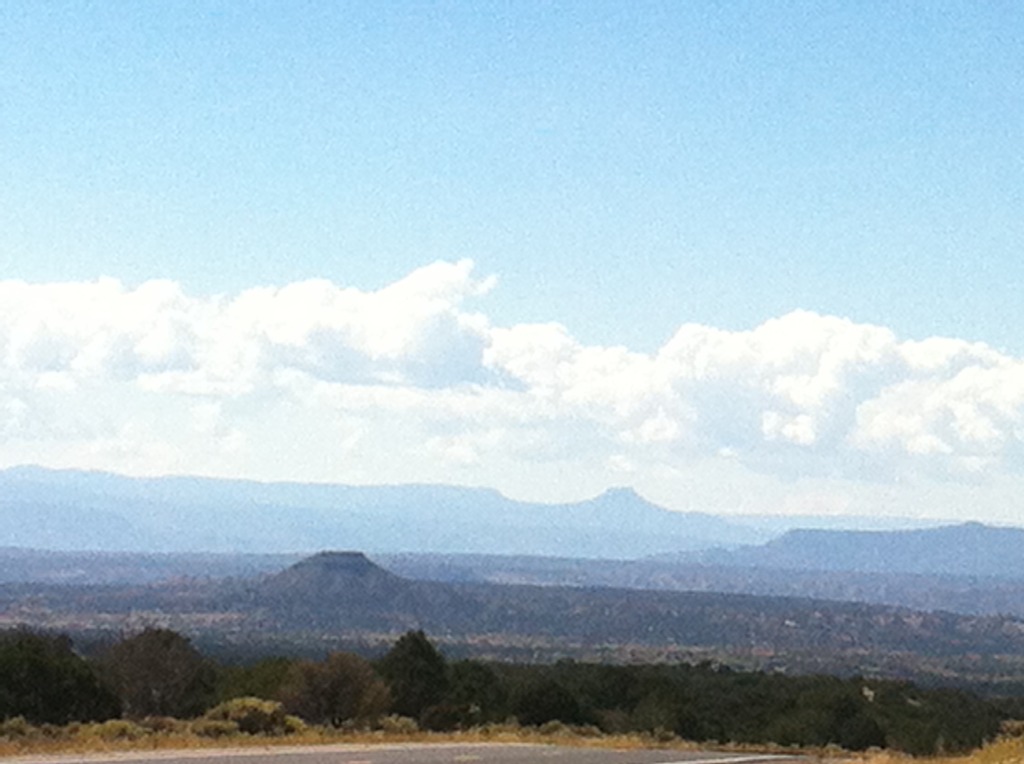
“Let not your heart be disturbed.”
The highway is leading toward Upaya Zen Center. In Sanskrit, upaya is “skillful means,” using wisdom and compassion in our interactions with others to help them grow toward enlightenment. Medios hábil: interesting that in Spanish, being able means being skillful, not just having the potential capacity to do something. You don’t just talk a good game – you get it done. The Spanish translation feels more Zen than the Sanskrit. Not a hope, but a direct statement. Not intention, but training.
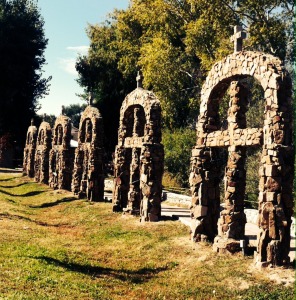 The words may sound direct, but this is New Mexico…where walls and buildings, earth and sky, all curve. So I curve, too, down a slight detour, the winding road to Chimayo. It has been almost 20 years since I have seen this small adobe chapel, and after many U-turns and missed signs, I am not completely sure I am yet on the right road. Passing tiny, dilapidated houses, dirt yards fenced in chainlink, and gardens of chiles and squash behind jacal pickets, I pull into the ubiquitous Family Dollar store parking lot, just behind a local couple getting out of a 20-year-old green Toyota. I roll down my window. “May I ask you a question? Is this the road to Chimayo?”
The words may sound direct, but this is New Mexico…where walls and buildings, earth and sky, all curve. So I curve, too, down a slight detour, the winding road to Chimayo. It has been almost 20 years since I have seen this small adobe chapel, and after many U-turns and missed signs, I am not completely sure I am yet on the right road. Passing tiny, dilapidated houses, dirt yards fenced in chainlink, and gardens of chiles and squash behind jacal pickets, I pull into the ubiquitous Family Dollar store parking lot, just behind a local couple getting out of a 20-year-old green Toyota. I roll down my window. “May I ask you a question? Is this the road to Chimayo?”
Chimayo reminds me of the word chimera, “something that exists only in imagination and is not possible in reality.” I feel like I’m asking if this is the road to magic and miracles. I think of the story of Juan Diego and Our Lady on the Hill: Juanito is just this regular guy who heard beautiful birdsong coming from the hilltop and decided to turn from the main road and wander up to see what magic this might be. Following the winding way itself became his miracle.
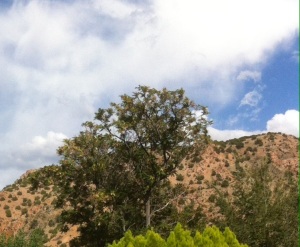
The name Chimayo actually derives from a Tewa Indian name for the hill of Tsi Mayoh, one of four sacred hills marking the four sacred directions. The soil itself was believed to have healing powers by the Tewa, who called it “blessed earth,” and this belief was picked up by Spanish settlers in the 1600s who founded the village of Chimayo on the ruin of a Tewa pueblo. In 1814, the source for digging the blessed earth, El Posito, was contained within a small church built to honor El Señor de Esquipulas, the Black Christ worshipped in Guatemala credited with healing abilities. Medios hábil. Maybe this was skillful means. Layer upon layer, like a laying on of hands, these centuries of beliefs in miraculous healing. All circling around this sacred opening in the earth.
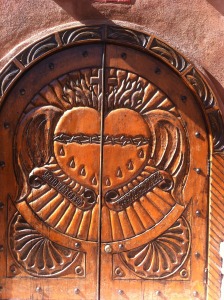
The grey-haired husband is coming around the car, smiling.
“The, uh, chapel?” I ask again.
“Santuario? Santuario de Chimayo?”
“Yes – santuario! Is this the road?” I am given specific instructions, to pass the ranchos, to look for a man’s small service station and turn there.
The woman, older than me but ageless in her grace, smiles slowly, then broadly. “This – is Chimayo.” She raises her arms as she smiles, her hands lifting palms up to the sky. “All this, all…is…Chimayo!”
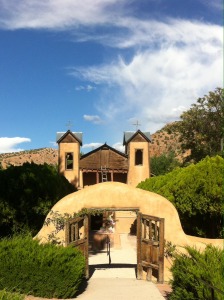 Santuario. I am seeking sanctuary, at the same time I am seeking the skills to better offer compassion and help in the world. Our Lady of Family Dollar is so wise; all this, all this is in fact the sacred hill we climb, our Tsi Mayoh, our Tepeyac, seeking the voice of the Great Mother who sings like birds, and the warmth of the Sun God on our faces, seeking the high holy place, and the deep source of healing.
Santuario. I am seeking sanctuary, at the same time I am seeking the skills to better offer compassion and help in the world. Our Lady of Family Dollar is so wise; all this, all this is in fact the sacred hill we climb, our Tsi Mayoh, our Tepeyac, seeking the voice of the Great Mother who sings like birds, and the warmth of the Sun God on our faces, seeking the high holy place, and the deep source of healing.
“Am I not your health? Do not fear that sickness, nor any other sickness or anguish.”
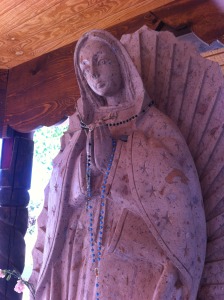 She is here as well, at Santuario de Chimayo. The Guadalupana. She is everywhere here on the rolling road to the city of holy faith…so many names, so many layers, so many incarnations.
She is here as well, at Santuario de Chimayo. The Guadalupana. She is everywhere here on the rolling road to the city of holy faith…so many names, so many layers, so many incarnations.
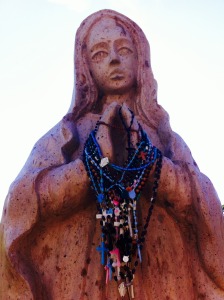 I wind my way back toward Española, then south. In Santa Fe, I take the Paseo de Peralta, curving into yet more quiet hills. I have traveled to Upaya to remember the meaning of the zendo, the holy place of practicing the stillness of the hills to quiet our noisy minds, the temple named Dokanji – Circle of the Way. Circulo del Camino. So many words, so many voices, in so many languages.
I wind my way back toward Española, then south. In Santa Fe, I take the Paseo de Peralta, curving into yet more quiet hills. I have traveled to Upaya to remember the meaning of the zendo, the holy place of practicing the stillness of the hills to quiet our noisy minds, the temple named Dokanji – Circle of the Way. Circulo del Camino. So many words, so many voices, in so many languages.
Here in the forgiving spaciousness of New Mexico, I can feel that I am just a small pilgrim, hoping to make some progress on the way. And the way is winding, circular, spiral. Like the petals of the roses Our Lady gave to Juan Diego as proof of his honest heart.
Unseen birds are twittering in the cooling twilight as I arrive. I listen carefully. Because Juan Diego listened and took the curving path up the hill, he found The Lady. By following the call of beauty and meaning, the true magic, we learn that the most skillful means can be to meander among the miracles.
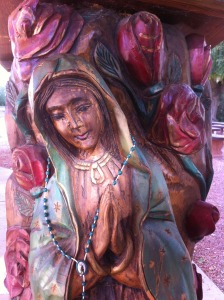
“What else do you wish? Do not grieve nor be disturbed by anything.”
September 30, 2014 / wanderinglightning / 0 Comments
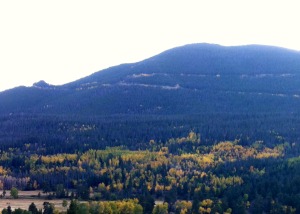 September in Rocky Mountain National Park is a postcard at every turn. If you live along the northern Front Range of the Colorado Rockies, you can drive up the Big Thompson Canyon, through Estes Park, and be saying hello to a park ranger in less than an hour.
September in Rocky Mountain National Park is a postcard at every turn. If you live along the northern Front Range of the Colorado Rockies, you can drive up the Big Thompson Canyon, through Estes Park, and be saying hello to a park ranger in less than an hour.
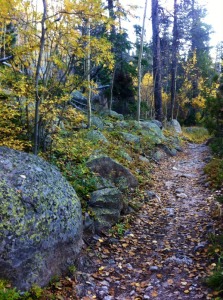
Hiking here is soothing. On the running trail at home, I listen to the crunch of my feet hitting the dry gravel, kicking loose rocks. Here the way leads up into the deep stillness of the pine and spruce forest. The last of the high snowmelt trickles down little gurgling streams, straight down the mountainside, and where these streams cross the trail, all is wet, mossy, and dark. Long tracks of trail are wet as I climb, my footsteps muffled by pine cones and soft needles, bits of fallen bark and Spanish moss, and aspen leaves strewn like rose petals up the aisle.
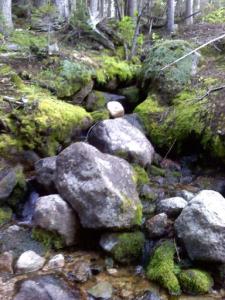
Sometimes I run this trail, but today I am hiking, because I want to go farther than usual. The voice of the lower reaches is Roaring River, pounding relentlessly down broken boulders and the very bedrock of the mountain. It still runs wild in autumn, when many Colorado rivers have slowed to almost nothing.
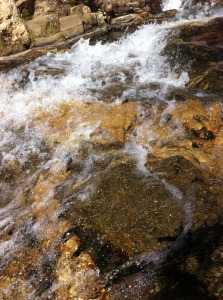 Until this summer, I thought this was the Fall River. I thought I knew. The trailhead is off Fall River Road, this is the river along that trail, and Estes Park is filled with “Fall River” this and that. For 30 years, I thought I was becoming intimately familiar with Fall River, the churning falls seemingly the namesake.
Until this summer, I thought this was the Fall River. I thought I knew. The trailhead is off Fall River Road, this is the river along that trail, and Estes Park is filled with “Fall River” this and that. For 30 years, I thought I was becoming intimately familiar with Fall River, the churning falls seemingly the namesake.
Only, no. Because I never checked the fairly logical assumption I made when I first hiked the Lawn Lake Trail at 18, I have believed – all my adult life – that I knew what I was talking about. I have believed that my logical, rational mind was my most powerful tool.
And so I have believed a myth of my own making.
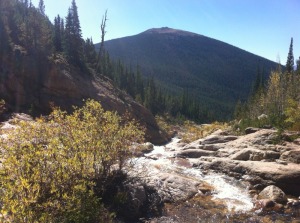 So obvious, now that I know. If any river in Colorado should be named the Roaring River, this one is it. The Roaring River’s banks are ripped high into the side of the mountain, trees toppled in, boulders the size of the ranger’s entrance station huts hanging precariously from the exposed dirt. In the flood of 1982, it tore loose from Lawn Lake and flooded Horseshoe Park and the town of Estes Park. You’d think I would have noticed, maybe listened to the detailed news reports that told how the old earthen dam at Lawn Lake built in 1903 gave way one warm, sunny, summer day, sending all the lake’s water down the Roaring River at 18,000 cubic feet per second. That’s catastrophic: 5,000 cubic ft/sec is a dangerous class 5 rapids. Water literally roared down the river in a 25-foot-tall flood wave. But I was 16 then, listening to American Top 40 on the radio that summer. I didn’t pay attention, and so, I didn’t know.
So obvious, now that I know. If any river in Colorado should be named the Roaring River, this one is it. The Roaring River’s banks are ripped high into the side of the mountain, trees toppled in, boulders the size of the ranger’s entrance station huts hanging precariously from the exposed dirt. In the flood of 1982, it tore loose from Lawn Lake and flooded Horseshoe Park and the town of Estes Park. You’d think I would have noticed, maybe listened to the detailed news reports that told how the old earthen dam at Lawn Lake built in 1903 gave way one warm, sunny, summer day, sending all the lake’s water down the Roaring River at 18,000 cubic feet per second. That’s catastrophic: 5,000 cubic ft/sec is a dangerous class 5 rapids. Water literally roared down the river in a 25-foot-tall flood wave. But I was 16 then, listening to American Top 40 on the radio that summer. I didn’t pay attention, and so, I didn’t know.
There’s so much we think we know…who we are, what is or is not possible, where the edges of the map are and where there be dragons. We create a personal mythology to make sense of our lives, to hold back the floodwaters of chaos and pain, but then the story takes over, and, as Murray Stein says in Facing the Gods, “The individual is unconsciously living a myth rather than a life.” We start losing authentic resonance with new experience. Because we decide we already know how the story goes.
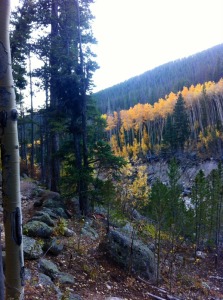 Zen master Suzuki taught a summation of the teachings of Buddhism: “not always so.”
Zen master Suzuki taught a summation of the teachings of Buddhism: “not always so.”
Maybe we should check our assumptions about what is true. Maybe life is bigger than we think. Maybe there’s a whole world out there, happening. Maybe we should find out what we’re talking about.
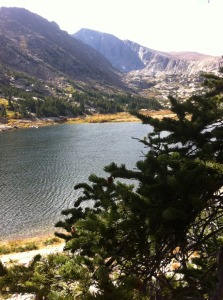
I made my way to Lawn Lake. But rather than take a break on the grassy flat banks and head back down the trail as usual – I just kept going. At first curious to see the lake-area campsites, I soon realized I was headed not only along the shoreline but up through a wooded rise and past the lake itself. I had found the trail I had seen others on years earlier, high on the mountainside above the lake, a trail I had longed to follow. As I realized where I was headed, I came to a good-sized tree fallen squarely across the path.
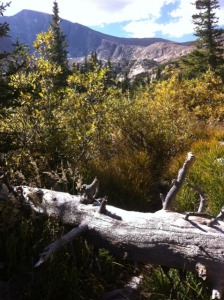 Deliberate though this gate may be, the trail clearly led on beyond it, equally intentional. No signs indicated whether the trail was open or closed. So I decided…that…I don’t know. I looked around me, but I had left everyone else behind. I looked up at the high country ahead. I looked down at the tree trunk. And then I climbed over.
Deliberate though this gate may be, the trail clearly led on beyond it, equally intentional. No signs indicated whether the trail was open or closed. So I decided…that…I don’t know. I looked around me, but I had left everyone else behind. I looked up at the high country ahead. I looked down at the tree trunk. And then I climbed over.
Often I am pragmatic, practical and safety-conscious. But I am “not always so.” While I’m exploring the larger world that’s out there, happening, with or without me, I have to let go my tight hold on what I “know,” if I want to expand my map of the world I live in.
Lawn Lake sits at 11,000 feet, and it was rapidly dwindling below me as I crossed soggy drainages filled with bushy willows as high as my head. Moose habitat, I thought, or elk, and mindfulness was suddenly pragmatic. Beyond the willows, one last stand of gnarled, wind-twisted bristlecone pines ushered me to the tundra above treeline, where dirt trails and rock cairns led to the Crystal Lakes hidden within a massive cirque, or to the Saddle, a relatively smooth pass between peaks.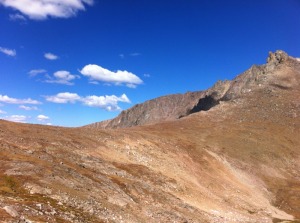 Starting up the saddle trail, I scrambled over boulders, crisscrossing the drainage streams under a cloudless blue sky, the warm sun and cool mountain air exhilarating. Lifting my gaze to the peak above, I climbed from boulder pile to stone outcropping to rock ledge in the thin tundra soil. Soon I was above the saddle, above Crystal Lakes, and on my way toward the top of the mountain.
Starting up the saddle trail, I scrambled over boulders, crisscrossing the drainage streams under a cloudless blue sky, the warm sun and cool mountain air exhilarating. Lifting my gaze to the peak above, I climbed from boulder pile to stone outcropping to rock ledge in the thin tundra soil. Soon I was above the saddle, above Crystal Lakes, and on my way toward the top of the mountain. 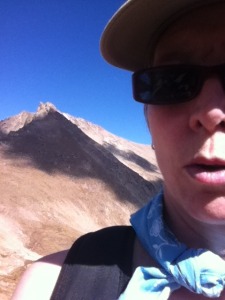
But by now, it was nearly 2:30. Mountain wisdom sends us all down from the high peaks before 2:00, always, and I saw the first clouds rolling over, creating shadows across the mountainsides. Happy to just be here now, I started down, this time toward the Crystal Lakes. I hiked along the rugged clifftops, looking down over the edges here and there at the smooth blue-green pools, the water-carved stone basins undulating like dragons under the surface.
I felt…ancient. Hiking along across tundra and square-bouldered cliffs and watching the changing sky, I felt connected to this immense, silent mountain, huge into the earth beneath me, and to the ancient people who have hiked across similar terrain, all over the world, for millenia. I felt incredibly human. 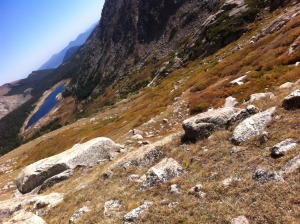
It’s disorienting, too, though. So much of our daily life is spent down low, looking up. Buildings tower over us, bosses stand in the doorway talking with us seated at our desks, trees and hillsides and road signs all require us to crane our necks upward as we pass under. Here I looked above me directly into the immense sky, standing level with the tops of huge mountain peaks. Most of the immediate world lay below me, and standing on the steep slopes viewing the familiar through this unfamiliar lens, my definition of feeling human was stretched in new ways, as well.
Today I had hiked to almost 13,000 feet, higher than the pass between hooked Hagues Peak and Fairchild Mountain, that great cirque enclosing the stone dragons within crystal lakes. I had looked across the top of the 12,541-foot unnamed peak on Lawn Lake’s west shore, and stood face to face with 13,425-foot Mummy Mountain across the lake valley. Facing the gods, in mythology. In reality, facing my own insignificance, vulnerability, and mortality, without a heroic story to cling to. It’s disorienting and unfamiliar to go beyond the known edges of our maps, the world tilting away beneath our feet as we look up into the great unknown above. But this is where we find new meaning, the headwaters of all that sustains us.
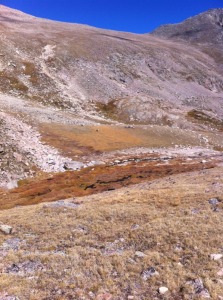
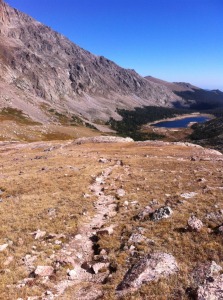
“In risking the unknown, we gain a sense of life itself.” — Jack Kornfield, A Path With Heart
I made it down to the trailhead as the elk began bugling into the early twilight. I looked back up at the peaks miles away, listening to the river, wondering at my day. I had stood on the cirque cliffs, where eagles circled. And I soon became painfully aware that I had stood there without sunscreen. Fairchild Mountain indeed. I knew better than to forget the power of the sun at altitude, and winced as I dabbed cold aloe vera gel onto my red neck and shoulders, laughing wryly, “well, not always so.” I had at last traveled the Roaring River.
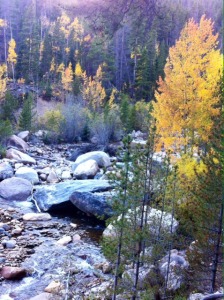
September 24, 2014 / wanderinglightning / 0 Comments
This is my running trail. 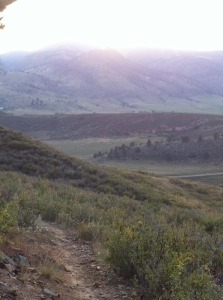 Here in northern Colorado, the world smells like granite, dry clay, baked grasses, and ponderosa pine, and sounds like wild canyon rivers and the wind through cottonwoods. I live on the edges of things here – edge of the foothills but not yet mountains, edge of town but not quite in, edge of middle class but really working poor, edge of conforming but never really two feet in that circle.
Here in northern Colorado, the world smells like granite, dry clay, baked grasses, and ponderosa pine, and sounds like wild canyon rivers and the wind through cottonwoods. I live on the edges of things here – edge of the foothills but not yet mountains, edge of town but not quite in, edge of middle class but really working poor, edge of conforming but never really two feet in that circle.
The edges are where wild things live, at the confluence of safety and need. Wildlife tends to travel along the boundaries, a treed fenceline, the edge of a meadow, just below ridgeline, trying to stay hidden, while trying to find food, water, and each other.
Finding what nourishes us is often at odds with what soothes and protects us. We want to feel happy, fulfilled and nourished by our work, our homes, our circle of friends and family, our choices. Yet again and again, we prioritize against our own fulfillment. We choose the safe path, the beaten trail.
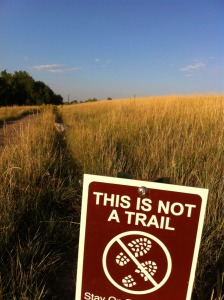 Safety is supposed to keep us alive while we find what we need to really live. For me, that safety has meant always having a steady day job and a house, supporting my family. For decades, I have prioritized responsibility and duty. I’m a big believer that kids need stability to thrive, and I have followed that path, missteps notwithstanding. But my family of chattering children have become a tribe of grown human beings, out making their lives.
Safety is supposed to keep us alive while we find what we need to really live. For me, that safety has meant always having a steady day job and a house, supporting my family. For decades, I have prioritized responsibility and duty. I’m a big believer that kids need stability to thrive, and I have followed that path, missteps notwithstanding. But my family of chattering children have become a tribe of grown human beings, out making their lives.
I’ve always been a fan of the credo, “If you’re not living on the edge, you’re taking up too much space.”
So my plan is to spiral out of control. No drama, no freaking out. Just letting go. Running away. Trekking away. Or biking away, sailing away. Taking that road less traveled by whatever means available. And letting “way lead on to way,” my favorite part of that Robert Frost poem.
This is not a trail. This spiral is more like the yellow brick road, which starts to uncoil at your feet the minute you seek it…and leads you on the adventure to your own courage, intelligence, and compassion, your heart’s truest desires, which is the grand adventure of your actual life. The spiral road just keeps widening, to encompass the whole world, and I’m going to go – literally.
Wild, isn’t it?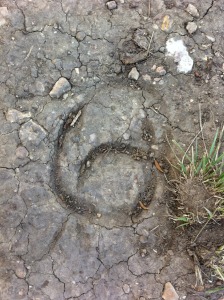
September 21, 2014 / wanderinglightning / 0 Comments
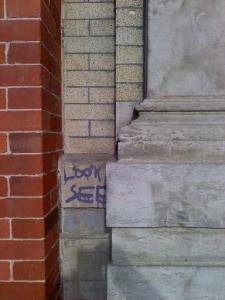
According to Merriam-Webster:
1. wan•der•ing (adj): characterized by aimless, slow, or pointless movement; not keeping a rational or sensible course; to follow a path with many turns
2. light•ning (n): the flashing of light produced by a discharge of atmospheric electricity; the discharge itself; a sudden stroke of fortune
3. wan•der•ing light•ning (English translation from Danish): my name
4. Dan•ish (adj): my heritage, ancestry, surname
5. po•et•ic ser•en•dip•i•ty (descriptive phrase): finding beautiful and unexpected alignments, instances of what John Welwood calls “ordinary magic,” inducing astonishment, wonder, gratitude
6. a•quar•i•an (adj): one born under the double lightning bolt sign of Aquarius, the sign of the humanitarian friend, stubborn will, absent-minded genius, unexplained interference with electricity, unique relationship to time, and passionate love of freedom:
a) Aquarius horoscope September 2006: “You find poetry in daily happenings and compose songs out of ordinary emotions. Your method is simple: capture an elusive thought, hold it in your mind, and sing it to yourself.”
b) Aquarius horoscope February 2008: “Our love is a well in the wilderness where time watches over the wandering lightning. – Pablo Neruda”
c) Aquarius horoscope May 2008: “When the spell is broken, Aquarius, you will be able to tap into resources that you’ve been cut off from. When the spell is broken, you will finally notice three big, beautiful secrets that have been staring you in the face. When the spell is broken, you will slip down off a clean, lofty perch where it has been hard to relax and arrive at a low, funky spot where you’ll be free to feel things you haven’t felt in a long time. When the spell is broken, it will be because you have decided to break it.”
 It used to be the Masonic Temple. The imposing stone edifice stood its ground on an angled spit of land at the crooked corner of 32nd and Speer, like a huge ship run aground on a tiny island, looming as night came on. Still, the golden wooden doors looked warm and inviting. Enter here for zazen, the sign read, and it was then I noticed one of the doors barely open, it’s extended deadbolt holding it ajar. The subtlest welcome. I stepped inside.
It used to be the Masonic Temple. The imposing stone edifice stood its ground on an angled spit of land at the crooked corner of 32nd and Speer, like a huge ship run aground on a tiny island, looming as night came on. Still, the golden wooden doors looked warm and inviting. Enter here for zazen, the sign read, and it was then I noticed one of the doors barely open, it’s extended deadbolt holding it ajar. The subtlest welcome. I stepped inside. The Zen Center of Denver is a hundred shades of reassuring old brown, from the golden doors and the tan stone exterior to the dark wooden benches built U-shaped into creamy marble alcoves, the polished French doors to the soft matte of the self-stitched robes worn by the practitioners here. A tiny stone Kuan Yin (called Kannon here) is esconced in a wonderful little wooden cabinet centered above the bench where I sat after I was welcomed in. I had never seen this version, Kuan Yin as a mother with small children reaching up to her in the familiar pose of tired little ones, wanting uppie, uppie mama. It touched me, taking me back decades, to the days when my kids were that little…the days when we lived in Denver. A votive candle flickered beside her, a small glass dish of rice left in offering, a small carnation in a diminutive vase. I had expected a stiff initial response at the door, some slight wariness, formality; what surprised me here was the understated earthiness, the utter normalcy – being talked to in ordinary voices, using completely ordinary phrases. Kuan Yin like a young mother. People came and went, small and brown, a genial group with quiet laughter and smiles filling the antechamber to the zendo as we waited together, like sparrows hopping contentedly on the sidewalk outside, finding sunflower seeds in the cracks.
The Zen Center of Denver is a hundred shades of reassuring old brown, from the golden doors and the tan stone exterior to the dark wooden benches built U-shaped into creamy marble alcoves, the polished French doors to the soft matte of the self-stitched robes worn by the practitioners here. A tiny stone Kuan Yin (called Kannon here) is esconced in a wonderful little wooden cabinet centered above the bench where I sat after I was welcomed in. I had never seen this version, Kuan Yin as a mother with small children reaching up to her in the familiar pose of tired little ones, wanting uppie, uppie mama. It touched me, taking me back decades, to the days when my kids were that little…the days when we lived in Denver. A votive candle flickered beside her, a small glass dish of rice left in offering, a small carnation in a diminutive vase. I had expected a stiff initial response at the door, some slight wariness, formality; what surprised me here was the understated earthiness, the utter normalcy – being talked to in ordinary voices, using completely ordinary phrases. Kuan Yin like a young mother. People came and went, small and brown, a genial group with quiet laughter and smiles filling the antechamber to the zendo as we waited together, like sparrows hopping contentedly on the sidewalk outside, finding sunflower seeds in the cracks. When we choose a spiritual practice, we frame it in the language of the practice itself. So Christians talk about letting go of the things of this world, of being called by the Holy Spirit into a deeper relationship with Jesus, looking to the Blessed Trinity of Father / Son / Holy Ghost, while Buddhists talk about letting go of attachments and taking refuge in the Buddha, the Dharma, and the Sangha, the Three Jewels. Sangha is the Buddhist equivalent of the Christian congregation, the community of saints, which is really the community of sinners who kept trying, really hard. Is there a difference then ultimately, between sinners and saints? Between me, boddhisattvas (those saints of the Buddhist tradition), and the Buddha? The Buddha being just a guy named Siddhartha, similar to a guy named Jesus. Real people, trying to find meaning as a refuge in their real lives, great teachers to other people seeking meaning, seeking refuge, safe shelter.
When we choose a spiritual practice, we frame it in the language of the practice itself. So Christians talk about letting go of the things of this world, of being called by the Holy Spirit into a deeper relationship with Jesus, looking to the Blessed Trinity of Father / Son / Holy Ghost, while Buddhists talk about letting go of attachments and taking refuge in the Buddha, the Dharma, and the Sangha, the Three Jewels. Sangha is the Buddhist equivalent of the Christian congregation, the community of saints, which is really the community of sinners who kept trying, really hard. Is there a difference then ultimately, between sinners and saints? Between me, boddhisattvas (those saints of the Buddhist tradition), and the Buddha? The Buddha being just a guy named Siddhartha, similar to a guy named Jesus. Real people, trying to find meaning as a refuge in their real lives, great teachers to other people seeking meaning, seeking refuge, safe shelter.

















































































